Paul van Yperen's Blog, page 76
August 29, 2023
High Society (1956)
The American musical High Society (1956) is a musical remake of The Philadelphia Story (1940) which was based on the 1939 play 'The Philadelphia Story' by Philip Barry. Bing Crosby plays C.K. Dexter-Haven, a popular jazz musician, who lives in a mansion near his ex-wife Tracy Lord's family estate. Tracy (Grace Kelly) is on the verge of marrying a man blander and safer than Dex. Of course, Dex tries to win Tracy's heart again. Mike Connor (Frank Sinatra), an undercover tabloid reporter, also falls for Tracy while covering the wedding for Spy magazine. Tracy must choose between the three men as she discovers that "safe" can mean "deadly dull" when it comes to husbands and life. High Society was Kelly's last film before she married Prince Rainier III and became Princess Consort of Monaco.
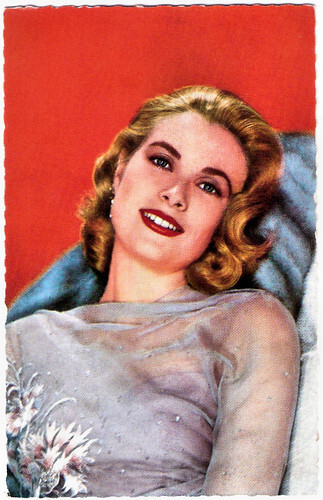
West-German postcard by Kolibri-Verlag G.m.b.H., Minden (Westf.), no. F 38. Photo: Metro-Goldwyn-Mayer (MGM). Grace Kelly in High Society (Charles Walters, 1956).
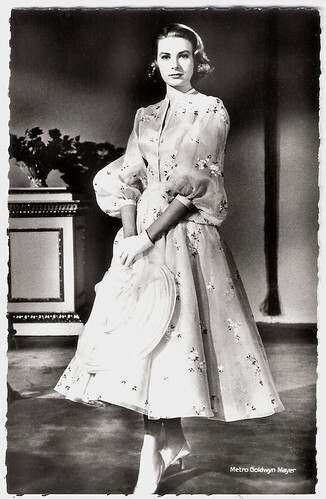
French postcard by Editions du Globe, Paris, no. 496. Photo: Virgil Apger / Metro Goldwyn Mayer. Key-set portrait from High Society (Charles Walters, 1956). Helen Rose designed the costumes. She also designed Grace Kelly 's wedding gown for her marriage to Prince Ranier.
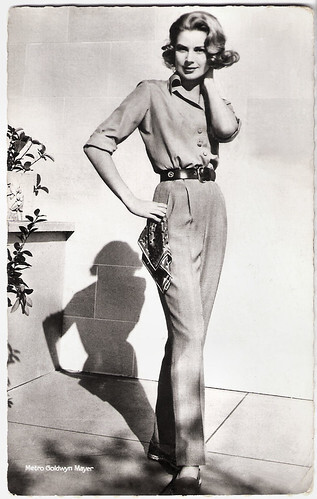
French postcard by Editions du Globe, Paris, no. 498. Photo: Virgil Apger / Metro Goldwyn Mayer. Key-set portrait from High Society (Charles Walters, 1956).
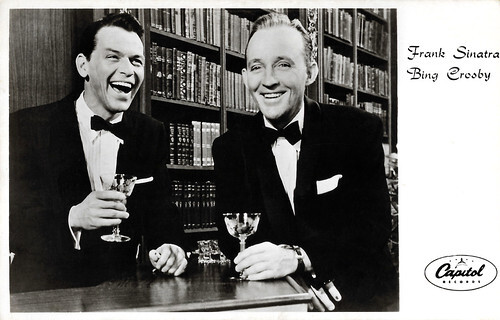
Dutch postcard by Editions Altona, Amsterdam / Gebr. Spanjersberg, Rotterdam, no. 5135. Photo: Capitol Records. Frank Sinatra and Bing Crosby in High Society (Charles Walters, 1956).
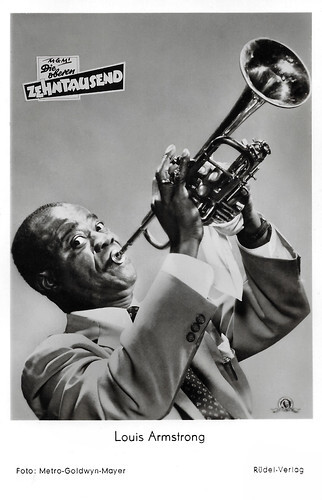
German postcard by Rüdel-Verlag, Hamburg-Bergedorf, no. 1988. Photo: MGM. Louis Armstrong in High Society (Charles Walters, 1956). The German title of the film is Die oberen Zehntausend.
A glossy Technicolor-and-VistaVision musical remake
High Society (Charles Walters, 1956) is a glossy Technicolor-and-VistaVision musical remake of George Cukor's classic The Philadelphia Story (1940), starring Katharine Hepburn , Cary Grant , and James Stewart . Both were based on Philip Barry's enormously successful stage 1939 comedy of manners.
Set amongst the rich and famous in Newport, RI, the story revolves around the wedding plans of spoiled heiress Tracy Lord ( Grace Kelly ). Tracy is all set to marry stuffy social climber George Kittridge (John Lund), while undercover Spy magazine reporter Mike Connor ( Frank Sinatra ) and photographer Liz Imbrie (Celeste Holm) intend to cover the ceremony.
Meanwhile, Tracy's ex-husband C.K. Dexter-Haven (Bing Crosby), a successful jazz musician who lives next door, also comes calling. Ostensibly, he is there to attend the annual Newport Jazz Festival, but actually, he wants to win Tracy back.
In the course of events, Mike falls in love with Tracy, and she with him. Tracy has to choose between the three men. The Jazz Festival subplot allows scriptwriter John Patrick to bring Louis Armstrong and his band into the proceedings.
Minus points are the casting of Crosby who appears old enough to be Kelly's grandfather ( Grace Kelly was 26, Bing Crosby was 53) and obviously misses the looks and the class of Cary Grant , and the fact that the more satiric aspects of Philip Barry's witty dialogue seem to have been sanded away. But we love these Cole Porter tunes like the Crosby-Sinatra duet 'Well, Did You Evah?,' the Crosby-Armstrong teaming 'Now You Has Jazz,' the Kelly-Crosby romantic ballad 'True Love,' and the Sinatra solo 'You're Sensational.'
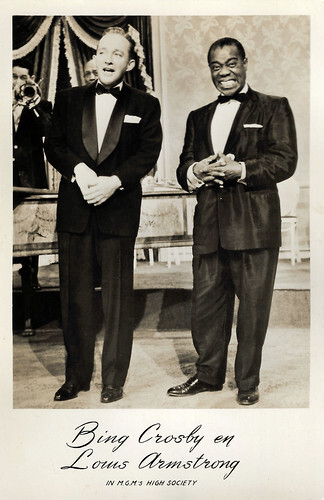
Dutch postcard by Uitg. Takken, Utrecht, no. 3014. Photo: MGM. Bing Crosby and Louis Armstrong in High Society (Charles Walters, 1956).
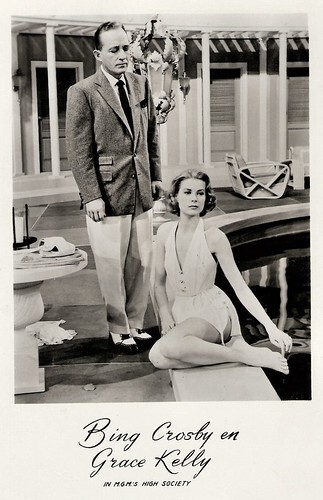
Dutch postcard by Uitg. Takken, Utrecht, no. 3015. Photo: MGM. Bing Crosby and Grace Kelly in High Society (Charles Walters, 1956).
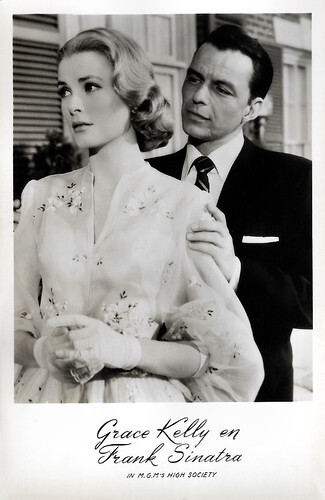
Dutch postcard by Uitg. Takken, Utrecht, no. 3016. Photo: MGM. Grace Kelly and Frank Sinatra in High Society (Charles Walters, 1956).
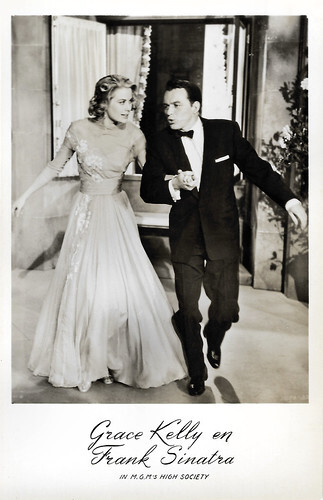
Dutch postcard by Uitg. Takken, Utrecht, no. 3017. Photo: MGM. Grace Kelly and Frank Sinatra in High Society (Charles Walters, 1956).
Sensational
Among the strong points of High Society (Charles Walters, 1956) are the songs. Producer Sol C. Siegel paid Cole Porter $250,000 for his first original film score in eight years. Louis Armstrong and his band get a couple of standout moments and Frank Sinatra and Bing Crosby collaborated for the first time. Behind the scenes, two master orchestrators – Conrad Salinger and Nelson Riddle – melded their arrangements under the baton of Johnny Green.
For Grace Kelly , High Society was her only musical. Though Tracy is the central character, Kelly does not sing a solo. She only accompanies Bing Crosby on 'True Love' and drunkenly shouts, 'Sensational'. Despite initial plans to dub her, Kelly sang her own part in 'True Love', which became a gold record.
Cole Porter wrote he song 'True Love' especially for the film. It became a million-seller and both Grace Kelly and Bing Crosby were awarded platinum records for the song. This is the only platinum record ever given to sitting royalty as Grace Kelly had become Princess Grace by the time it was awarded.
The song 'Well, Did You Evah?' came from a previous Cole Porter musical. It was originally performed by High Society's director) Charles Walters and Betty Grable in the 1939 Broadway musical 'DuBarry Was A Lady'. It was added at the last minute to High Society after the filmmakers realised that there wasn't a song for Bing Crosby and Frank Sinatra to sing together.
Although High Society is a remake of The Philadelphia Story, it is not set in Philadelphia. The setting was changed to Newport, Rhode Island, so the filmmakers could take advantage of the famous jazz festival held there.
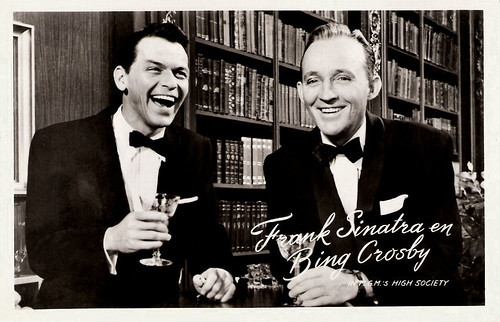
Dutch postcard by Uitg. Takken, Utrecht, no. 3020. Photo: MGM. Frank Sinatra and Bing Crosby in High Society (Charles Walters, 1956).
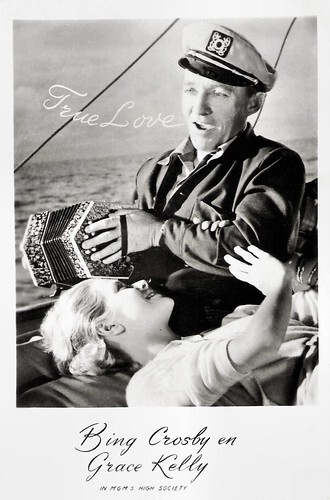
Dutch postcard by Uitg. Takken, Utrecht, no. 3021. Photo: Metro Goldwyn Mayer. Bing Crosby and Grace Kelly High Society (Charles Walters, 1956).
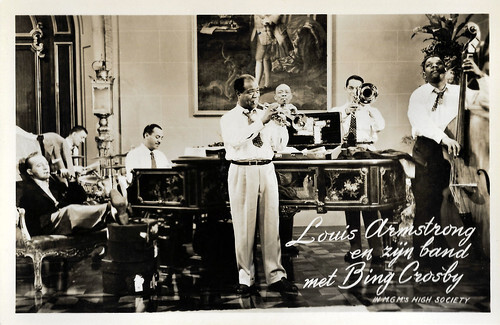
Dutch postcard by Uitg. Takken, Utrecht, no. 3022. Photo: MGM. Louis Armstrong and his band with Bing Crosby in High Society (Charles Walters, 1956).
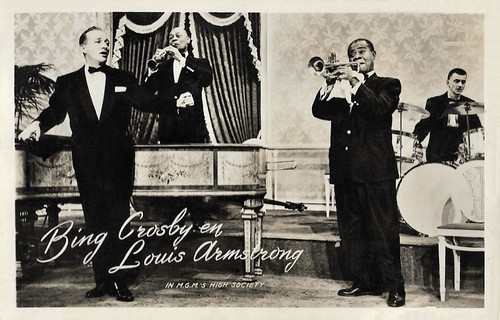
Dutch postcard by Uitg. Takken, Utrecht, no. 3024. Photo: MGM. Bing Crosby and Louis Armstrong in High Society (Charles Walters, 1956).
Sources: Hal Erickson (AllMovie), Michael Costello (AllMovie), Wikipedia and IMDb.

West-German postcard by Kolibri-Verlag G.m.b.H., Minden (Westf.), no. F 38. Photo: Metro-Goldwyn-Mayer (MGM). Grace Kelly in High Society (Charles Walters, 1956).

French postcard by Editions du Globe, Paris, no. 496. Photo: Virgil Apger / Metro Goldwyn Mayer. Key-set portrait from High Society (Charles Walters, 1956). Helen Rose designed the costumes. She also designed Grace Kelly 's wedding gown for her marriage to Prince Ranier.

French postcard by Editions du Globe, Paris, no. 498. Photo: Virgil Apger / Metro Goldwyn Mayer. Key-set portrait from High Society (Charles Walters, 1956).

Dutch postcard by Editions Altona, Amsterdam / Gebr. Spanjersberg, Rotterdam, no. 5135. Photo: Capitol Records. Frank Sinatra and Bing Crosby in High Society (Charles Walters, 1956).

German postcard by Rüdel-Verlag, Hamburg-Bergedorf, no. 1988. Photo: MGM. Louis Armstrong in High Society (Charles Walters, 1956). The German title of the film is Die oberen Zehntausend.
A glossy Technicolor-and-VistaVision musical remake
High Society (Charles Walters, 1956) is a glossy Technicolor-and-VistaVision musical remake of George Cukor's classic The Philadelphia Story (1940), starring Katharine Hepburn , Cary Grant , and James Stewart . Both were based on Philip Barry's enormously successful stage 1939 comedy of manners.
Set amongst the rich and famous in Newport, RI, the story revolves around the wedding plans of spoiled heiress Tracy Lord ( Grace Kelly ). Tracy is all set to marry stuffy social climber George Kittridge (John Lund), while undercover Spy magazine reporter Mike Connor ( Frank Sinatra ) and photographer Liz Imbrie (Celeste Holm) intend to cover the ceremony.
Meanwhile, Tracy's ex-husband C.K. Dexter-Haven (Bing Crosby), a successful jazz musician who lives next door, also comes calling. Ostensibly, he is there to attend the annual Newport Jazz Festival, but actually, he wants to win Tracy back.
In the course of events, Mike falls in love with Tracy, and she with him. Tracy has to choose between the three men. The Jazz Festival subplot allows scriptwriter John Patrick to bring Louis Armstrong and his band into the proceedings.
Minus points are the casting of Crosby who appears old enough to be Kelly's grandfather ( Grace Kelly was 26, Bing Crosby was 53) and obviously misses the looks and the class of Cary Grant , and the fact that the more satiric aspects of Philip Barry's witty dialogue seem to have been sanded away. But we love these Cole Porter tunes like the Crosby-Sinatra duet 'Well, Did You Evah?,' the Crosby-Armstrong teaming 'Now You Has Jazz,' the Kelly-Crosby romantic ballad 'True Love,' and the Sinatra solo 'You're Sensational.'

Dutch postcard by Uitg. Takken, Utrecht, no. 3014. Photo: MGM. Bing Crosby and Louis Armstrong in High Society (Charles Walters, 1956).

Dutch postcard by Uitg. Takken, Utrecht, no. 3015. Photo: MGM. Bing Crosby and Grace Kelly in High Society (Charles Walters, 1956).

Dutch postcard by Uitg. Takken, Utrecht, no. 3016. Photo: MGM. Grace Kelly and Frank Sinatra in High Society (Charles Walters, 1956).

Dutch postcard by Uitg. Takken, Utrecht, no. 3017. Photo: MGM. Grace Kelly and Frank Sinatra in High Society (Charles Walters, 1956).
Sensational
Among the strong points of High Society (Charles Walters, 1956) are the songs. Producer Sol C. Siegel paid Cole Porter $250,000 for his first original film score in eight years. Louis Armstrong and his band get a couple of standout moments and Frank Sinatra and Bing Crosby collaborated for the first time. Behind the scenes, two master orchestrators – Conrad Salinger and Nelson Riddle – melded their arrangements under the baton of Johnny Green.
For Grace Kelly , High Society was her only musical. Though Tracy is the central character, Kelly does not sing a solo. She only accompanies Bing Crosby on 'True Love' and drunkenly shouts, 'Sensational'. Despite initial plans to dub her, Kelly sang her own part in 'True Love', which became a gold record.
Cole Porter wrote he song 'True Love' especially for the film. It became a million-seller and both Grace Kelly and Bing Crosby were awarded platinum records for the song. This is the only platinum record ever given to sitting royalty as Grace Kelly had become Princess Grace by the time it was awarded.
The song 'Well, Did You Evah?' came from a previous Cole Porter musical. It was originally performed by High Society's director) Charles Walters and Betty Grable in the 1939 Broadway musical 'DuBarry Was A Lady'. It was added at the last minute to High Society after the filmmakers realised that there wasn't a song for Bing Crosby and Frank Sinatra to sing together.
Although High Society is a remake of The Philadelphia Story, it is not set in Philadelphia. The setting was changed to Newport, Rhode Island, so the filmmakers could take advantage of the famous jazz festival held there.

Dutch postcard by Uitg. Takken, Utrecht, no. 3020. Photo: MGM. Frank Sinatra and Bing Crosby in High Society (Charles Walters, 1956).

Dutch postcard by Uitg. Takken, Utrecht, no. 3021. Photo: Metro Goldwyn Mayer. Bing Crosby and Grace Kelly High Society (Charles Walters, 1956).

Dutch postcard by Uitg. Takken, Utrecht, no. 3022. Photo: MGM. Louis Armstrong and his band with Bing Crosby in High Society (Charles Walters, 1956).

Dutch postcard by Uitg. Takken, Utrecht, no. 3024. Photo: MGM. Bing Crosby and Louis Armstrong in High Society (Charles Walters, 1956).
Sources: Hal Erickson (AllMovie), Michael Costello (AllMovie), Wikipedia and IMDb.
Published on August 29, 2023 22:00
August 28, 2023
Charles Prince
Charles Prince (1872-1933) or Prince was a French film actor, director and writer of silent slapstick films. In the years before World War I, he was the second most popular film star in the world, just behind his rival Max Linder. His character Rigadin featured in more than 200 shorts.
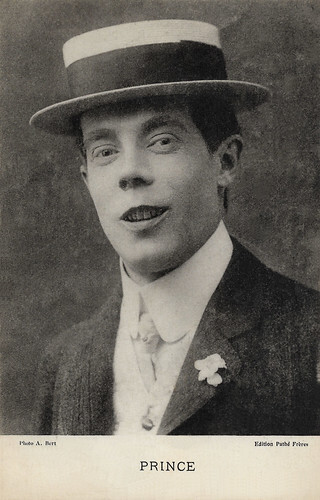
French postcard by Edition Pathé Frères. Photo: A. Bert.
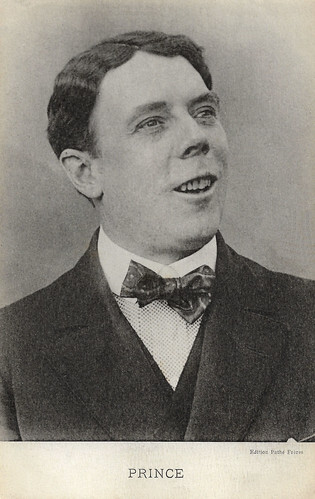
French postcard by Edition Pathé Frères.
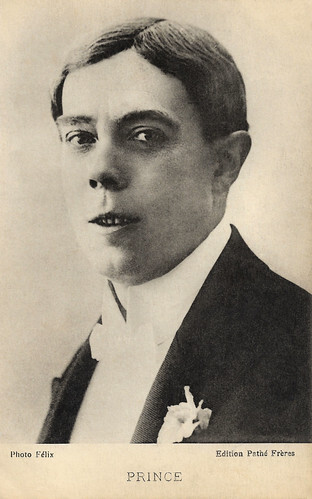
French postcard by Edition Pathé Frères. Photo: Félix.
Pathé
Charles Ernest René Petitdemange better known as Charles Prince was born at Maisons-Laffitte, France in 1872 – though some mention his birthplace as Petitdemange, near Paris. Prince’s father was a manufacturer of artificial silk and had planned for his son to study commerce and assist him. Prince chose otherwise.
He had his theatrical debut in 1896 at the Theatre de l’Odéon in the play 'La Bodinière', using a first pseudonym: Seigneur. Around the turn-of-the-century, Charles took the stage name of Prince. He became a popular boulevard theatre star, cherished for his comic performances at the Theatre des Variétés, as in Ma Tante de Honfleur.
After a decade, Pathé Frères hired him in 1908 to act in their films. Right from the beginning almost all his films were directed by Georges Monca, mostly for the Pathé subsidiary SCAGL (Société Cinématographique des Auteurs et Gens de Lettres). In 1909 Prince acted in almost 20 shorts. He co-starred with Mistinguett in Fleur de pavé/Flower pad (Michel Carré, Albert Capellani, 1909).
This number increased in 1910 when Prince introduced his character Rigadin: ¾ of his film performances that year – over 30 films - were as Rigadin. Monca directed all of the Rigadin shorts. While in 1911 Prince played in 23 Rigadin comedies, 1912 was a top year with some 45 Rigadin shorts. In 1913 Prince did 30 Rigadin shorts. In 1914 22 Rigadin films despite the outbreak of the First World War and the temporary collapse of the French film industry.
In the early 1910s, Prince and Rigadin were extremely popular throughout the world, rivalling – the now better-known - Max Linder . What both actors helped, was that they worked for Pathé Frères. Pathé was the first multinational in film history. It had a clockwork production output, massive distribution and promotion around the globe, and even its own global network of cinemas. In Germany Rigadin was known as Moritz, in Britain and the US as Whiffles, in Italy as Tartufini, in Spain as Salustiano, and in Russia as Prenz. Prince had a remarkable face with a curling lip showing his teeth and an upturned nose, for which he even mocked himself in Le Nez de Rigadin/Rigadin's Nose (1911).
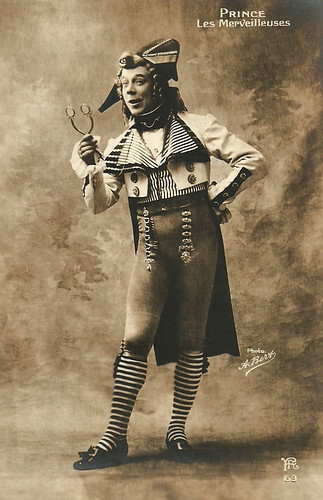
French postcard by FA, no. 63. Photo: A. Bert. Publicity still for Les merveilleuses.
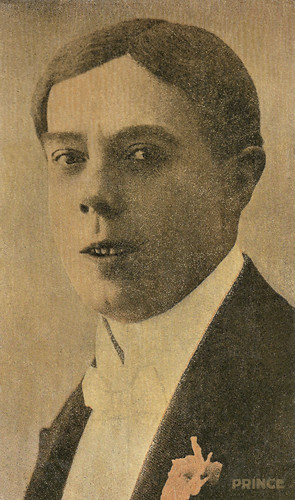
Spanish collectors card by Chocolate Amatller, Marc Luna, in the series Principales Artistas Cinematograficos, Serie 1a, no. 21. Photo: Félix.
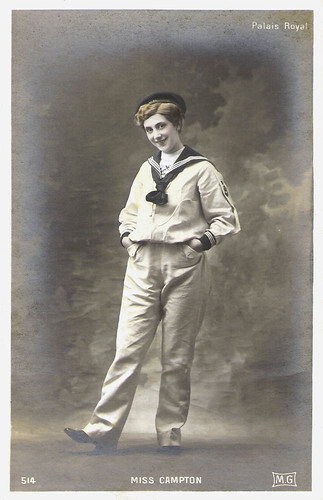
French postcard by M.G., no. 514. Caption: Palais-Royal. Miss Campton.
Rigadin
As Rigadin, Prince often played the bourgeois who gets in trouble with authorities or with love interests, because of his timidity and clumsiness. Just like Prince’s previous stage performances, the Rigadin comedies thus mocked pre-war bourgeois drama and their main topic of amour, even if Prince himself occasionally acted in these bourgeois dramas as well.
In contrast to the previous anarchic comedy at Pathé and other companies, Rigadin was inspired by vaudeville and light stage comedy, and so Prince’s character stuck to ‘white collar’ respectability and convention while being pestered by mothers-in-law or his own mistresses. In Rigadin n’aime pas le vendredi 13/Rigadin does not like Friday the 13th (1911) for instance, Rigadin has dinner with his fiancée and her parents, but it is Friday the 13th and Rigadin is so superstitious that everything goes wrong.
In La Garçonnière de Rigadin (1912) Rigadin lends his bachelor flat to his future father-in-law, not knowing ‘Papa’ is going to use it for his secret rendezvous. In contrast to Linder, Prince also made Rigadin do countless transformations in all kinds of professions, from domestic, cook, chestnut seller, poet, singer and explorer to the president of the French Republic and Napoleon. In Rigadin peintre cubiste/Rigadin Cubist Painter (1912) Prince mocked avant-garde art by having Rigadin and his model wear angular clothes.
In Rigadin aux Balkans/Rigadin at the Balkan (1912) Prince played a war cameraman who fakes scenes for the camera in France. During the First World War, the number of Rigadin comedies went down from some 20 films in 1915, to 16 in 1916, 13 in 1917, and 11 in 1918. Still, Prince must have acted in some 200 shorts as of 1908, mostly Rigadin comedies.
Prince also experimented with the exchange between stage and screen. In the war revue show Nouvelle Revue, shown at the Paris Theatre Antoine in 1915, a notary Rigadin from the countryside is appalled by a film poster suggesting he has an affair with a girl and visits a Parisian cinema. There he speaks to the Rigadin on the screen, until the other turns around and starts to speak with him. When the notary tries to pursue him, he is suddenly in the film.
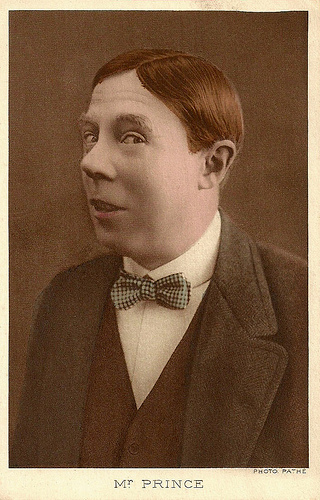
French postcard. Photo: Pathé. Platinogravure.
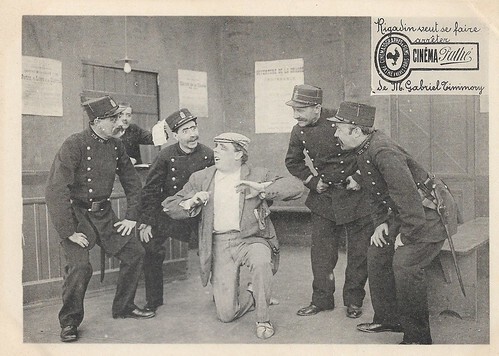
French collector's card. Large format printed publicity stills from an album of Pathé Frères films, dating 1911. Charles Prince in the French silent comedy Rigadin veut se faire arrêter (Georges Monca, S.C.A.G.L., 1911). Scripted by Gabriel Timmory. Pathé distributed the film. The film was strongly based on an earlier film with a similar plot: 'La purée veut se faire arrêter' (1908), in which a bum eats without paying thus hoping to get food and lodging at the police station. Yet, he manages to get away with it. When he suddenly gets money and orders a huge meal, the restaurant owner warns the police and our poor bum is arrested after all.
Prince pissed off by Rigadin
In all these years, the number of films in which Prince wasn’t Rigadin was really small. As of 1913, Prince acted in long(er) features as well, mostly dramas. In 1913 he thus acted opposite Léon Bernard and Suzanne Demay in the SCAGL production Les Surprises du divorce/Divorce Surprises, directed by Georges Monca.
Then followed Le Bon juge/The Good Judge, Le Coup de fouet/The Whiplash, Ferdinand le noceur/Ferdinand the playboy, Le Fils à papa/Son to dad and Monsieur le directeur/Mr. Director, all co-directed in 1913 by Monca and Prince himself. Subsequent long films were in 1914 Les Trente millions de Gladiator, Bébé, La Famille Boléro, La Femme à papa (all co-directed by Prince and Monca) and Les Fiançés héroïques (Georges Monca, 1914), in 1915 L’Auréole de la gloire and La Main dans le sac (both by Monca), in 1916 La Mariée récalcitrante (Monca, Prince).
In 1919-1921 Prince played in a few feature-length comedies, again all directed by Monca, such as Les Femmes Collantes/The sticky women (1919-1920) and Madame et son filleul/Madame and Her Godchild (1919). One last time he played in a Rigadin short, probably mocking his own dissatisfaction or that of the spectators, as the title was Prince embêté par Rigadin/Prince pissed off by Rigadin (1920).
By the early 1920s, though, not only the popularity of Rigadin but also that of Prince had faded, and for years Prince didn’t act in film anymore. In 1928, he made one last silent film, Embrassez-moi by Robert Péguy and Max de Rieux. Between 1930 and 1933, he had an active career in the early French sound cinema. He now played supporting roles, as in Maurice Tourneur’s Partir/Go (1931) and Pierre Colombier’s Sa Meilleure cliente/Her best client (1932), starring Elvire Popesco and René Lefèvre .
Then Prince died at Saint-Maur-des-Fossés, France in 1933. He was only 61. In 1910 Prince had shortly been married to vaudeville and film actress Miss (Aimée) Campton . They had one daughter Renée (1901), who died in 1993. Campton was the cousin of Paul Derval, director of the Folies-Bergères. Prince's great-grandson is French film director Cris Ubermann.
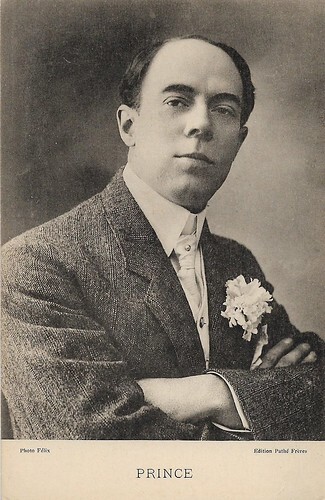
French postcard by Édition Pathé Frères. Photo: Félix.
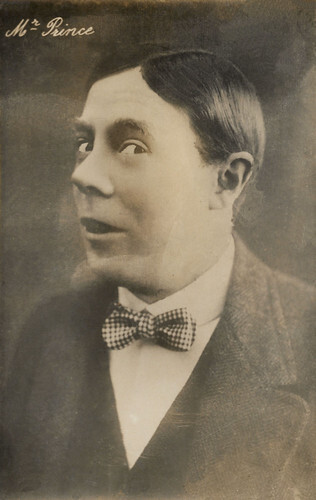
Spanish postcard. Photo: Pathé.
Sources: Richard Abel (The Ciné Goes to Town), The Bioscope., Eva Krivanec (Theatre und Medien/Theatre and the Media), Adrien Vernardin (Le Musée du Music-Hall), various obituaries in newspapers, Bibliothèque du Film, Wikipedia (French and English), and .

French postcard by Edition Pathé Frères. Photo: A. Bert.

French postcard by Edition Pathé Frères.

French postcard by Edition Pathé Frères. Photo: Félix.
Pathé
Charles Ernest René Petitdemange better known as Charles Prince was born at Maisons-Laffitte, France in 1872 – though some mention his birthplace as Petitdemange, near Paris. Prince’s father was a manufacturer of artificial silk and had planned for his son to study commerce and assist him. Prince chose otherwise.
He had his theatrical debut in 1896 at the Theatre de l’Odéon in the play 'La Bodinière', using a first pseudonym: Seigneur. Around the turn-of-the-century, Charles took the stage name of Prince. He became a popular boulevard theatre star, cherished for his comic performances at the Theatre des Variétés, as in Ma Tante de Honfleur.
After a decade, Pathé Frères hired him in 1908 to act in their films. Right from the beginning almost all his films were directed by Georges Monca, mostly for the Pathé subsidiary SCAGL (Société Cinématographique des Auteurs et Gens de Lettres). In 1909 Prince acted in almost 20 shorts. He co-starred with Mistinguett in Fleur de pavé/Flower pad (Michel Carré, Albert Capellani, 1909).
This number increased in 1910 when Prince introduced his character Rigadin: ¾ of his film performances that year – over 30 films - were as Rigadin. Monca directed all of the Rigadin shorts. While in 1911 Prince played in 23 Rigadin comedies, 1912 was a top year with some 45 Rigadin shorts. In 1913 Prince did 30 Rigadin shorts. In 1914 22 Rigadin films despite the outbreak of the First World War and the temporary collapse of the French film industry.
In the early 1910s, Prince and Rigadin were extremely popular throughout the world, rivalling – the now better-known - Max Linder . What both actors helped, was that they worked for Pathé Frères. Pathé was the first multinational in film history. It had a clockwork production output, massive distribution and promotion around the globe, and even its own global network of cinemas. In Germany Rigadin was known as Moritz, in Britain and the US as Whiffles, in Italy as Tartufini, in Spain as Salustiano, and in Russia as Prenz. Prince had a remarkable face with a curling lip showing his teeth and an upturned nose, for which he even mocked himself in Le Nez de Rigadin/Rigadin's Nose (1911).

French postcard by FA, no. 63. Photo: A. Bert. Publicity still for Les merveilleuses.

Spanish collectors card by Chocolate Amatller, Marc Luna, in the series Principales Artistas Cinematograficos, Serie 1a, no. 21. Photo: Félix.

French postcard by M.G., no. 514. Caption: Palais-Royal. Miss Campton.
Rigadin
As Rigadin, Prince often played the bourgeois who gets in trouble with authorities or with love interests, because of his timidity and clumsiness. Just like Prince’s previous stage performances, the Rigadin comedies thus mocked pre-war bourgeois drama and their main topic of amour, even if Prince himself occasionally acted in these bourgeois dramas as well.
In contrast to the previous anarchic comedy at Pathé and other companies, Rigadin was inspired by vaudeville and light stage comedy, and so Prince’s character stuck to ‘white collar’ respectability and convention while being pestered by mothers-in-law or his own mistresses. In Rigadin n’aime pas le vendredi 13/Rigadin does not like Friday the 13th (1911) for instance, Rigadin has dinner with his fiancée and her parents, but it is Friday the 13th and Rigadin is so superstitious that everything goes wrong.
In La Garçonnière de Rigadin (1912) Rigadin lends his bachelor flat to his future father-in-law, not knowing ‘Papa’ is going to use it for his secret rendezvous. In contrast to Linder, Prince also made Rigadin do countless transformations in all kinds of professions, from domestic, cook, chestnut seller, poet, singer and explorer to the president of the French Republic and Napoleon. In Rigadin peintre cubiste/Rigadin Cubist Painter (1912) Prince mocked avant-garde art by having Rigadin and his model wear angular clothes.
In Rigadin aux Balkans/Rigadin at the Balkan (1912) Prince played a war cameraman who fakes scenes for the camera in France. During the First World War, the number of Rigadin comedies went down from some 20 films in 1915, to 16 in 1916, 13 in 1917, and 11 in 1918. Still, Prince must have acted in some 200 shorts as of 1908, mostly Rigadin comedies.
Prince also experimented with the exchange between stage and screen. In the war revue show Nouvelle Revue, shown at the Paris Theatre Antoine in 1915, a notary Rigadin from the countryside is appalled by a film poster suggesting he has an affair with a girl and visits a Parisian cinema. There he speaks to the Rigadin on the screen, until the other turns around and starts to speak with him. When the notary tries to pursue him, he is suddenly in the film.

French postcard. Photo: Pathé. Platinogravure.

French collector's card. Large format printed publicity stills from an album of Pathé Frères films, dating 1911. Charles Prince in the French silent comedy Rigadin veut se faire arrêter (Georges Monca, S.C.A.G.L., 1911). Scripted by Gabriel Timmory. Pathé distributed the film. The film was strongly based on an earlier film with a similar plot: 'La purée veut se faire arrêter' (1908), in which a bum eats without paying thus hoping to get food and lodging at the police station. Yet, he manages to get away with it. When he suddenly gets money and orders a huge meal, the restaurant owner warns the police and our poor bum is arrested after all.
Prince pissed off by Rigadin
In all these years, the number of films in which Prince wasn’t Rigadin was really small. As of 1913, Prince acted in long(er) features as well, mostly dramas. In 1913 he thus acted opposite Léon Bernard and Suzanne Demay in the SCAGL production Les Surprises du divorce/Divorce Surprises, directed by Georges Monca.
Then followed Le Bon juge/The Good Judge, Le Coup de fouet/The Whiplash, Ferdinand le noceur/Ferdinand the playboy, Le Fils à papa/Son to dad and Monsieur le directeur/Mr. Director, all co-directed in 1913 by Monca and Prince himself. Subsequent long films were in 1914 Les Trente millions de Gladiator, Bébé, La Famille Boléro, La Femme à papa (all co-directed by Prince and Monca) and Les Fiançés héroïques (Georges Monca, 1914), in 1915 L’Auréole de la gloire and La Main dans le sac (both by Monca), in 1916 La Mariée récalcitrante (Monca, Prince).
In 1919-1921 Prince played in a few feature-length comedies, again all directed by Monca, such as Les Femmes Collantes/The sticky women (1919-1920) and Madame et son filleul/Madame and Her Godchild (1919). One last time he played in a Rigadin short, probably mocking his own dissatisfaction or that of the spectators, as the title was Prince embêté par Rigadin/Prince pissed off by Rigadin (1920).
By the early 1920s, though, not only the popularity of Rigadin but also that of Prince had faded, and for years Prince didn’t act in film anymore. In 1928, he made one last silent film, Embrassez-moi by Robert Péguy and Max de Rieux. Between 1930 and 1933, he had an active career in the early French sound cinema. He now played supporting roles, as in Maurice Tourneur’s Partir/Go (1931) and Pierre Colombier’s Sa Meilleure cliente/Her best client (1932), starring Elvire Popesco and René Lefèvre .
Then Prince died at Saint-Maur-des-Fossés, France in 1933. He was only 61. In 1910 Prince had shortly been married to vaudeville and film actress Miss (Aimée) Campton . They had one daughter Renée (1901), who died in 1993. Campton was the cousin of Paul Derval, director of the Folies-Bergères. Prince's great-grandson is French film director Cris Ubermann.

French postcard by Édition Pathé Frères. Photo: Félix.

Spanish postcard. Photo: Pathé.
Sources: Richard Abel (The Ciné Goes to Town), The Bioscope., Eva Krivanec (Theatre und Medien/Theatre and the Media), Adrien Vernardin (Le Musée du Music-Hall), various obituaries in newspapers, Bibliothèque du Film, Wikipedia (French and English), and .
Published on August 28, 2023 22:00
August 27, 2023
Ernst Winar
Little-known Dutch actor Ernst Winar (1894-1978) appeared in 34 films between 1916 and 1955, in The Netherlands and Germany. He was also a film director and made 14 films between 1922 and 1955. Later he was the editor of the first, short films of Paul Verhoeven.
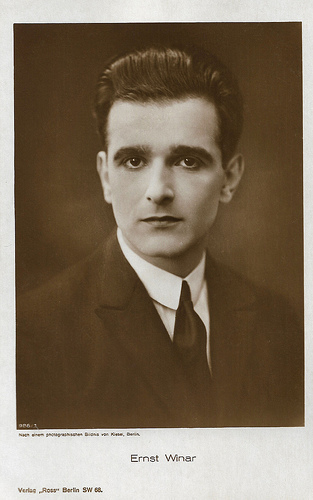
German postcard, no. 988/1, 1925-1926. Photo: Kiesel, Berlin.
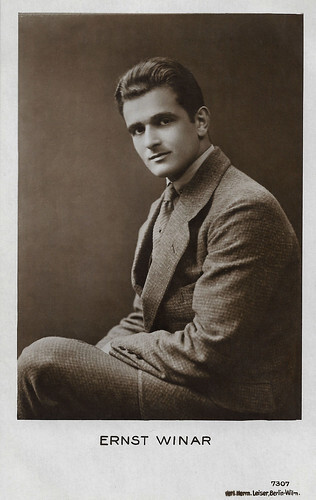
German postcard by Verl. Herm. Leiser, Berlin-Wilm., no. 7307.
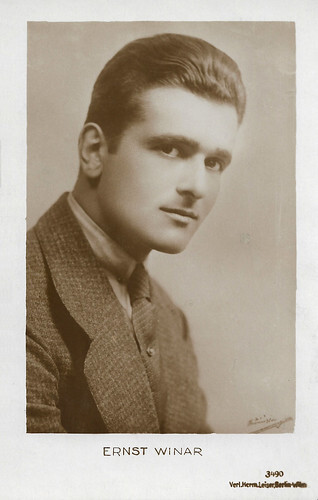
German postcard by Verl. Herm. Leiser, Berlin-Wilm., no. 3490.
Jack of all trades
Ernst Winar was born Joseph Wilhelm Carl von Eichhof-Winar from a German family in Leiden, The Netherlands, in 1894.
After finishing school he began a study engineering in Germany, but World War I forced him to break off his studies. Temporarily exempted from military service, he was employed by the Filmfabriek Hollandia (Film Factory Hollandia) in Haarlem as a real Jack of all trades. At Hollandia, he started as an actor in a small role in the silent film Majoor Frans/Major Francis (Maurits Binger, 1916) with Dutch diva Annie Bos in the lead.
Other silent Dutch films in which he appeared were La renzoni (Maurits Binger, 1916) again starring Annie Bos - the only star of the Dutch silent cinema, the opera film Gloria Transita (Johan Gildemeijer, 1917), Ulbo Garvema (Maurits Binger, 1917), De kroon der schande/The Crown of Shame (Maurits Binger, 1917) with Annie Bos and Adelqui Migliar , Toen 't licht verdween/Blind (Maurits Binger, 1918), and Pro domo (Theo Frenkel Sr., 1918) starring the legendary Dutch stage actor Louis Bouwmeester .
In these films, Winar usually appeared in a supporting role or even as an extra. After the war, he tried to gain a foothold as an actor. He played on stage under the name of W. Eikhof at the Casino Ensemble in The Hague. He also translated plays by Ferenc Molnar into Dutch, and he continued to appear in films. Een Carmen van het Noorden/A Carmen of the North (Maurits Binger, 1919) based on the novel by Prosper Mérimée, was a highlight among the films of the Filmfabriek Hollandia. This film featured again the stars Annie Bos and Adelqui Migliar and was a moderate international success.
Other films in which Winar appeared were De duivel in Amsterdam/The Devil in Amsterdam (Theo Frenkel Sr., 1919) based on Winar's translation of a Molnar play and starring Eduard Verkade as the devil and Louis Bouwmeester as a banker, and Verborgen levens/Fate's Plaything (Maurits Binger, B.E. Doxat-Pratt, 1920).
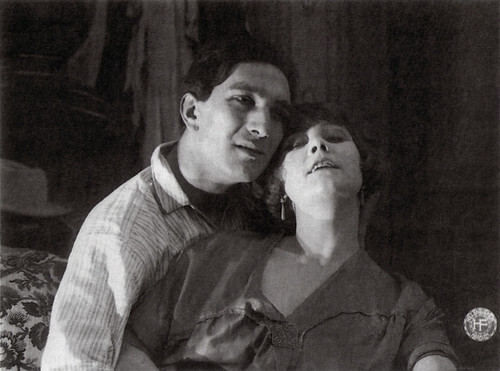
Publicity still for Een Carmen van het Noorden/A Carmen of the North (Maurits Binger, 1919) with Annie Bos and Adelqui Migliar . Source: Immagine. Nuova Serie N. 16, 1990-1991.
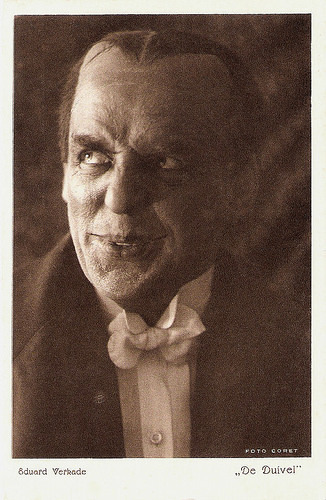
Dutch postcard. Photo: Coret, Den Haag. Picture of Eduard Verkade as the Devil in the stage play 'De duivel' (Az Ördög/The Devil) by Ferenc Molnár.
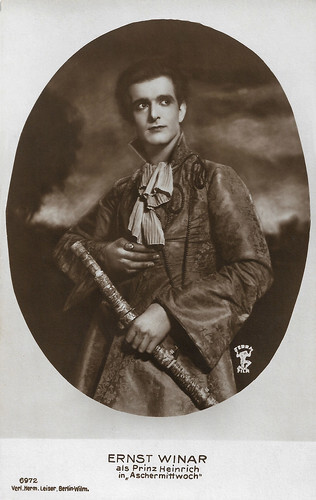
German postcard by Verl. Herm. Leiser, Berlin-Wilm., no. 6972. Photo: Terra-Film. Ernst Winar in Aschermittwoch/Ash Wednesday (Otto Rippert, 1921).
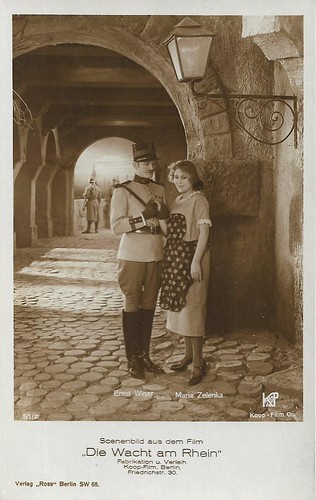
German postcard by Ross Verlag, Berlin, bo. 51/2. Photo: Koop-Film, Berlin. Ernst Winar as French Captain René Clavignac and Maria Zelenka as Maria Krenz, daughter of the castle owner August Krenz, in Die Wacht am Rhein. Aus des Rheinlands Schicksalstagen (Helene Lackner, 1925-1926).
Sought-after actor
In the 1920s Ernst Winar ventured into Germany as an actor but he also took the opportunity to direct several films. As an actor, he got his first major role in Die Benefizvorstellung der Vier Teufel/The benefit performance of the four devils (1920) by Danish director Anders Wilhelm Sandberg. The film was a success and numerous films followed.
The now sought-after actor appeared in such films as Der Liebling der Frauen/The Favorite of the Women (Carl Wilhelm, 1921) with the then largely unknown Maly Delschaft in the lead role, Der unsichtbare Gast/The invisible guest (Friedrich Zelnik, 1921), and Wettlauf ums Glück/Race to happiness (Bruno Ziener, 1923). In this love story located in Tibet, Winar starred alongside his future wife and frequent film partner, British actress Colette Brettel .
From 1921 on, Winar was also active as a director. First, he was responsible for three episodes of the Terra series Flappy with Adolphe Engers in the lead role. In 1922, he directed his first feature film, the crime film Der Mann im Hintergrund/The Man in the Background, but the film was released only after several changes in October 1924.
In the following four years, Winar mainly worked as an actor. He played supporting roles in the comedy Komödie des Herzens/The Comedy of the Heart (Rochus Gliese, 1924) with Lil Dagover , in Die Millionenkompagnie/The Millions Company (Fred Sauer, 1925) with Olga Tschechova , and the successful comedy Die Kleine vom Bummel/The little girl from Bummel (Richard Eichberg, 1925) starring Lilian Harvey . In 1923, he also taught directing at the Terra film school in Berlin.
His later German films as a director included Wochenend wider Willen/Weekend Against Sake (1927) starring Ossi Oswalda , Das Haus am Krögel/The House on Krögel (1927), Der Neffe aus Amerika/The Cousin From America (1927), Wochendbraut/Weekend Bride (1928) starring Anny Ondra , and Der Hafenbaron/The Port Baron (1928). Most of these films featured Colette Brettel . With his film § 182 minderjährig/Paragraph 182 – Minor of Age (1927) he got three times in conflict with the censors. With the advent of the sound film era his acting period in Germany ended. In 1930, he appeared for the last time in a German production, the Luis Trenker film Die heiligen drei Brunnen/The three holy wells (Mario Bonnard, 1930).
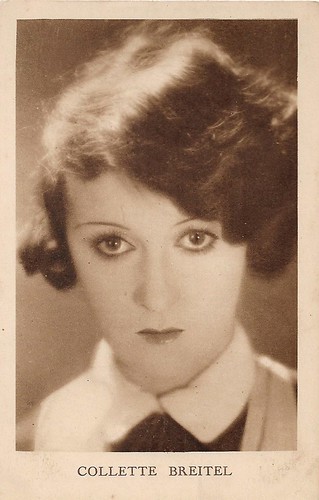
Belgian postcard by S.A. Cacao et Chocolat Kivou, Vilvoorde / N.V. Cacao en Chocolade Kivou, Vilvoorde. Photo: Artistes Associés (United Artists). Colette Brettel' s name is misspelt on this card.
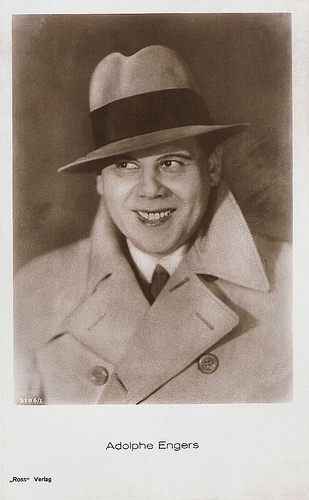
Adolphe Engers . German postcard by Ross Verlag, no. 3186/1, 1928-1929.
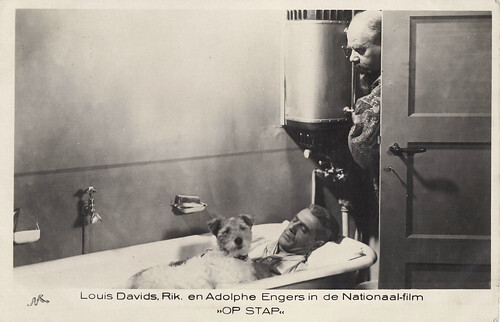
Dutch postcard by M.B. & Z. (M. Bonnist & Zonen, Amsterdam). Photo: Dick van Maarseveen, Den Haag / Nationaal Film. Louis Davids , Rik and Adolphe Engers in Op stap/On the Move (Ernst Winar, 1935).
On the road
In 1932 Ernst Winar returned to the Netherlands. He made the short sound film Hollandsch Hollywood/Dutch Hollywood (1934) for which revue star Fien de la Mar sang the title song, announcing a new Dutch film industry. In 1935 Winar and Fien de la Mar worked together again on the musical Op Stap/On the Road (Ernst Winar, 1935) which also featured revue stars Louis and Heintje Davids and Adolphe Engers , who was also back from Berlin.
For the Cinetone studios, Winar co-directed the film De Kribbebijter/The Double-Patch (1935) with German émigré director Hermann Kosterlitz aka Henry Koster as his co-director. This successful comedy starred Cor Ruys and Frits van Dongen , who later became a well-known film actor in Berlin and Hollywood under the name of Philip Dorn . Winar was one of the few Dutch directors who had mastered the trade of film directing and he would have a major impact in the 1940s and 1950s when the appearance of a Dutch feature film was rare.
During the war he presented De laatste dagen van een eiland/The Last days of an island (Ernst Winar, 1942) with Max Croiset , based on a story of Klaas Norel. The film was already recorded in 1938 and privately screened later that year, but only in 1942 publicly, probably because only a few films were approved by the German occupiers. It was the second film produced by the Dutch Christian Film Centre, but during the war, this organization was already shut down.
After the Second World War, Winar’s interest shifted to children's films, such as Dik Trom en zijn dorpsgenoten/Dik Trom and his fellow villagers (Ernst Winar, 1947) with his former director Theo Frenkel Sr. in one of the supporting roles, and Vier jongens en een jeep/Four guys and a jeep (Ernst Winar, 1955) with Sylvain Poons . The latter film was his last feature as a director and he also made his final film appearance in it.
During the 1960s, Winar escorted the young filmmaker Paul Verhoeven as the editor of the short films Een Hagedis teveel/A Lizard Too Much (Paul Verhoeven, 1960), De Lifters/The Hitchhikers (Paul Verhoeven, 1962), Feest!/Party! (Paul Verhoeven, 1963) and Het Korps Mariniers/The Royal Dutch Marine Corps (Paul Verhoeven, 1965). He also worked for the Foundation Film en Wetenschap (Film and Science) in Utrecht. In 1976 he finally appeared one more time in a small role in the TV film Volk en vaderliefde/People and Father Love (Wim T. Schippers, 1976) based on the story by Herodotus. Ernst Winar died in 1978 in Leiden, aged 83.
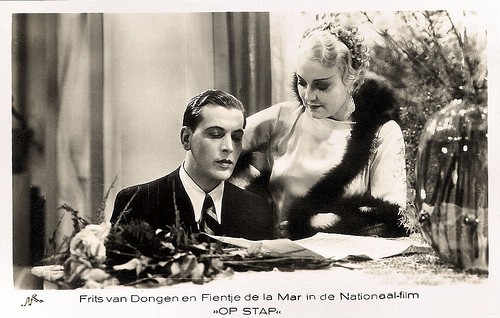
Dutch postcard by M.B. & Z. (M. Bonnist & Zonen, Amsterdam). Photo: Dick van Maarseveen, Den Haag / Nationaal Film. Publicity still for Op stap/On the Move (Ernst Winar, 1935) with Frits van Dongen and Fien de la Mar .
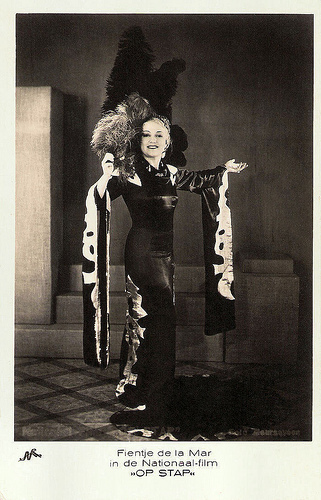
Dutch postcard by M.B. & Z. (M. Bonnist & Zonen, Amsterdam). Photo: Dick van Maarseveen, Den Haag / Nationaal Film. Publicity still of Fien(tje) de la Mar in Op stap/On the Move (Ernst Winar, 1935).
The final scene from Op Stap/On the Road (Ernst Winar, 1935) with Fien de la Mar and a dozen pianos. Source: Captainvontrapp (YouTube).
Sources: Fred van Doorn/Peter van Bueren (Filmbijlage VN 1975), Deutsches Filminstitut (German), Wikipedia and .

German postcard, no. 988/1, 1925-1926. Photo: Kiesel, Berlin.

German postcard by Verl. Herm. Leiser, Berlin-Wilm., no. 7307.

German postcard by Verl. Herm. Leiser, Berlin-Wilm., no. 3490.
Jack of all trades
Ernst Winar was born Joseph Wilhelm Carl von Eichhof-Winar from a German family in Leiden, The Netherlands, in 1894.
After finishing school he began a study engineering in Germany, but World War I forced him to break off his studies. Temporarily exempted from military service, he was employed by the Filmfabriek Hollandia (Film Factory Hollandia) in Haarlem as a real Jack of all trades. At Hollandia, he started as an actor in a small role in the silent film Majoor Frans/Major Francis (Maurits Binger, 1916) with Dutch diva Annie Bos in the lead.
Other silent Dutch films in which he appeared were La renzoni (Maurits Binger, 1916) again starring Annie Bos - the only star of the Dutch silent cinema, the opera film Gloria Transita (Johan Gildemeijer, 1917), Ulbo Garvema (Maurits Binger, 1917), De kroon der schande/The Crown of Shame (Maurits Binger, 1917) with Annie Bos and Adelqui Migliar , Toen 't licht verdween/Blind (Maurits Binger, 1918), and Pro domo (Theo Frenkel Sr., 1918) starring the legendary Dutch stage actor Louis Bouwmeester .
In these films, Winar usually appeared in a supporting role or even as an extra. After the war, he tried to gain a foothold as an actor. He played on stage under the name of W. Eikhof at the Casino Ensemble in The Hague. He also translated plays by Ferenc Molnar into Dutch, and he continued to appear in films. Een Carmen van het Noorden/A Carmen of the North (Maurits Binger, 1919) based on the novel by Prosper Mérimée, was a highlight among the films of the Filmfabriek Hollandia. This film featured again the stars Annie Bos and Adelqui Migliar and was a moderate international success.
Other films in which Winar appeared were De duivel in Amsterdam/The Devil in Amsterdam (Theo Frenkel Sr., 1919) based on Winar's translation of a Molnar play and starring Eduard Verkade as the devil and Louis Bouwmeester as a banker, and Verborgen levens/Fate's Plaything (Maurits Binger, B.E. Doxat-Pratt, 1920).

Publicity still for Een Carmen van het Noorden/A Carmen of the North (Maurits Binger, 1919) with Annie Bos and Adelqui Migliar . Source: Immagine. Nuova Serie N. 16, 1990-1991.

Dutch postcard. Photo: Coret, Den Haag. Picture of Eduard Verkade as the Devil in the stage play 'De duivel' (Az Ördög/The Devil) by Ferenc Molnár.

German postcard by Verl. Herm. Leiser, Berlin-Wilm., no. 6972. Photo: Terra-Film. Ernst Winar in Aschermittwoch/Ash Wednesday (Otto Rippert, 1921).

German postcard by Ross Verlag, Berlin, bo. 51/2. Photo: Koop-Film, Berlin. Ernst Winar as French Captain René Clavignac and Maria Zelenka as Maria Krenz, daughter of the castle owner August Krenz, in Die Wacht am Rhein. Aus des Rheinlands Schicksalstagen (Helene Lackner, 1925-1926).
Sought-after actor
In the 1920s Ernst Winar ventured into Germany as an actor but he also took the opportunity to direct several films. As an actor, he got his first major role in Die Benefizvorstellung der Vier Teufel/The benefit performance of the four devils (1920) by Danish director Anders Wilhelm Sandberg. The film was a success and numerous films followed.
The now sought-after actor appeared in such films as Der Liebling der Frauen/The Favorite of the Women (Carl Wilhelm, 1921) with the then largely unknown Maly Delschaft in the lead role, Der unsichtbare Gast/The invisible guest (Friedrich Zelnik, 1921), and Wettlauf ums Glück/Race to happiness (Bruno Ziener, 1923). In this love story located in Tibet, Winar starred alongside his future wife and frequent film partner, British actress Colette Brettel .
From 1921 on, Winar was also active as a director. First, he was responsible for three episodes of the Terra series Flappy with Adolphe Engers in the lead role. In 1922, he directed his first feature film, the crime film Der Mann im Hintergrund/The Man in the Background, but the film was released only after several changes in October 1924.
In the following four years, Winar mainly worked as an actor. He played supporting roles in the comedy Komödie des Herzens/The Comedy of the Heart (Rochus Gliese, 1924) with Lil Dagover , in Die Millionenkompagnie/The Millions Company (Fred Sauer, 1925) with Olga Tschechova , and the successful comedy Die Kleine vom Bummel/The little girl from Bummel (Richard Eichberg, 1925) starring Lilian Harvey . In 1923, he also taught directing at the Terra film school in Berlin.
His later German films as a director included Wochenend wider Willen/Weekend Against Sake (1927) starring Ossi Oswalda , Das Haus am Krögel/The House on Krögel (1927), Der Neffe aus Amerika/The Cousin From America (1927), Wochendbraut/Weekend Bride (1928) starring Anny Ondra , and Der Hafenbaron/The Port Baron (1928). Most of these films featured Colette Brettel . With his film § 182 minderjährig/Paragraph 182 – Minor of Age (1927) he got three times in conflict with the censors. With the advent of the sound film era his acting period in Germany ended. In 1930, he appeared for the last time in a German production, the Luis Trenker film Die heiligen drei Brunnen/The three holy wells (Mario Bonnard, 1930).

Belgian postcard by S.A. Cacao et Chocolat Kivou, Vilvoorde / N.V. Cacao en Chocolade Kivou, Vilvoorde. Photo: Artistes Associés (United Artists). Colette Brettel' s name is misspelt on this card.

Adolphe Engers . German postcard by Ross Verlag, no. 3186/1, 1928-1929.

Dutch postcard by M.B. & Z. (M. Bonnist & Zonen, Amsterdam). Photo: Dick van Maarseveen, Den Haag / Nationaal Film. Louis Davids , Rik and Adolphe Engers in Op stap/On the Move (Ernst Winar, 1935).
On the road
In 1932 Ernst Winar returned to the Netherlands. He made the short sound film Hollandsch Hollywood/Dutch Hollywood (1934) for which revue star Fien de la Mar sang the title song, announcing a new Dutch film industry. In 1935 Winar and Fien de la Mar worked together again on the musical Op Stap/On the Road (Ernst Winar, 1935) which also featured revue stars Louis and Heintje Davids and Adolphe Engers , who was also back from Berlin.
For the Cinetone studios, Winar co-directed the film De Kribbebijter/The Double-Patch (1935) with German émigré director Hermann Kosterlitz aka Henry Koster as his co-director. This successful comedy starred Cor Ruys and Frits van Dongen , who later became a well-known film actor in Berlin and Hollywood under the name of Philip Dorn . Winar was one of the few Dutch directors who had mastered the trade of film directing and he would have a major impact in the 1940s and 1950s when the appearance of a Dutch feature film was rare.
During the war he presented De laatste dagen van een eiland/The Last days of an island (Ernst Winar, 1942) with Max Croiset , based on a story of Klaas Norel. The film was already recorded in 1938 and privately screened later that year, but only in 1942 publicly, probably because only a few films were approved by the German occupiers. It was the second film produced by the Dutch Christian Film Centre, but during the war, this organization was already shut down.
After the Second World War, Winar’s interest shifted to children's films, such as Dik Trom en zijn dorpsgenoten/Dik Trom and his fellow villagers (Ernst Winar, 1947) with his former director Theo Frenkel Sr. in one of the supporting roles, and Vier jongens en een jeep/Four guys and a jeep (Ernst Winar, 1955) with Sylvain Poons . The latter film was his last feature as a director and he also made his final film appearance in it.
During the 1960s, Winar escorted the young filmmaker Paul Verhoeven as the editor of the short films Een Hagedis teveel/A Lizard Too Much (Paul Verhoeven, 1960), De Lifters/The Hitchhikers (Paul Verhoeven, 1962), Feest!/Party! (Paul Verhoeven, 1963) and Het Korps Mariniers/The Royal Dutch Marine Corps (Paul Verhoeven, 1965). He also worked for the Foundation Film en Wetenschap (Film and Science) in Utrecht. In 1976 he finally appeared one more time in a small role in the TV film Volk en vaderliefde/People and Father Love (Wim T. Schippers, 1976) based on the story by Herodotus. Ernst Winar died in 1978 in Leiden, aged 83.

Dutch postcard by M.B. & Z. (M. Bonnist & Zonen, Amsterdam). Photo: Dick van Maarseveen, Den Haag / Nationaal Film. Publicity still for Op stap/On the Move (Ernst Winar, 1935) with Frits van Dongen and Fien de la Mar .

Dutch postcard by M.B. & Z. (M. Bonnist & Zonen, Amsterdam). Photo: Dick van Maarseveen, Den Haag / Nationaal Film. Publicity still of Fien(tje) de la Mar in Op stap/On the Move (Ernst Winar, 1935).
The final scene from Op Stap/On the Road (Ernst Winar, 1935) with Fien de la Mar and a dozen pianos. Source: Captainvontrapp (YouTube).
Sources: Fred van Doorn/Peter van Bueren (Filmbijlage VN 1975), Deutsches Filminstitut (German), Wikipedia and .
Published on August 27, 2023 22:00
August 26, 2023
Eartha Kitt
Eartha Kitt (1927-2008) was an American singer, actress, dancer and cabaret star. She was known for her highly distinctive singing style and her 1953 hit recordings of 'C'est Si Bon' and the enduring Christmas hit 'Santa Baby'. She appeared in more than 30 films and played the role of Catwoman in the 1960s Batman television series. In 1984, she returned to the music charts with a disco song, 'Where Is My Man', the first certified gold record of her career. She was nominated three times for a Tony Award, once for Emmy Award and twice for a Grammy Award.

American postcard by Fotofolio, New York, no. PH50. Photo: Philippe Halsman. Caption: Eartha Kitt, 1954.
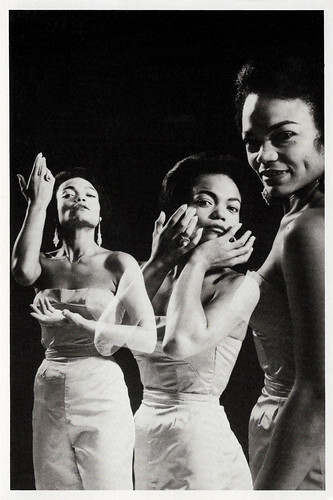
American postcard by the American Postcard Co. Inc., no. 326, 1981. Photo: Arthur Rothstein. Caption: Eartha Kitt, 1953.
The first Afro-American modern ballet company
Eartha Mae Kitt was born on a cotton plantation in North in the southern state of South Carolina in 1927. Her father was of European and her mother was of African-American and Cherokee descent. Her father soon disappeared. At the age of eight, she was sent to New York to live with her aunt.
A big opportunity came when, at the age of 16, she was accepted into the Katherine Dunham Company, the first Afro-American modern ballet company. She made her film debut as a dancer in Casbah (John Berry, 1948), starring Yvonne De Carlo .
Orson Welles gave her a leading role as Helen of Troy in his production of Christopher Marlowe's play 'The Tragical History of Doctor Faustus' (1950). Welles called her "the most exciting woman in the world". Kitt had her final breakthrough in the Broadway show 'New Faces of 1952', in which she sang the song 'Monotonous'.
As a singer, Kitt had a number of hits in the 1950s and 1960s, including 'Let's Do It', 'C'est Si Bon', 'Just an Old Fashioned Girl', 'Monotonous', 'Love for Sale', 'I'd Rather Be Burned as a Witch', and 'Under the Bridges of Paris'. Her debut LP 'RCA Victor Presents Eartha Kitt' (1953) was in the top five on the US album charts. The 1953 Christmas song 'Santa Baby', about a woman who promises Santa a date in exchange for expensive gifts, was later covered by Madonna , Kylie Minogue and Ariana Grande.
In 1954/1955 she starred on Broadway in 'Mrs. Patterson' and in 1957 in 'Shinbone Alley. In Hollywood, she made her debut as Sidney Poitier 's co-star in the film The Mark of the Hawk (Michael Audley, 1957), followed by St. Louis Blues (Allen Resiner, 1958) with Nat 'King' Cole and Anna Lucasta (Arnold Laven, 1958) with Sammy Davis Jr. She appeared in more than 30 films.
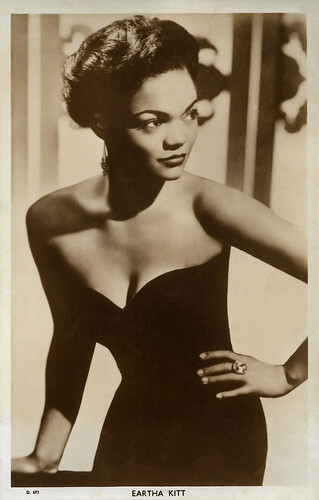
British postcard in the Picturegoer Series, London, no. D672.
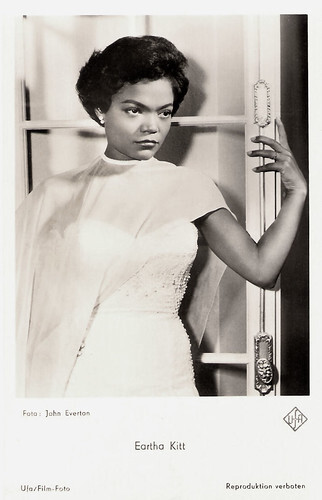
German postcard by Ufa/Film-Foto. Photo: John Everton.
Boycott and rehabilitation
In the 1960s, Eartha Kitt starred on Broadway in 'The Owl and the Pussycat'. On television, she appeared in the role of Catwoman in the series Batman as Julie Newmar 's successor. She also played a drug-addicted singer in Tennis Rackets and Guns (1965) and a guest role in Mission Impossible (1967). In Europe, she appeared in the film Onkel Toms Hütte/Uncle Tom's Cabin (Géza von Radványi, 1965), based on the novel 'Uncle Tom's Cabin'.
In 1968, at a White House luncheon, Kitt made Lady Bird Johnson, wife of US President Lyndon B. Johnson, cry with critical comments on the war in Vietnam. She bluntly told her, "You send the best of this country off to be shot and maimed. They rebel in the street. They don't want to go to school because they're going to be snatched off from their mothers to be shot in Vietnam." However, the public reaction to Kitt's statements was even more extreme both for and against her statements. After this, she was unable to get work in the United States and left for Europe, where she learned to speak French fluently.
This boycott ended in 1978 with rehabilitation by Jimmy Carter and she made her American comeback in the Broadway musical 'Timbuktu!' In the 1980s, she also made a comeback as a singer with the disco hits 'Where Is My Man' (1983), 'I Love Men' (1984), 'This Is My Life' (1986) and 'Cha-Cha Heels' (1989), a collaboration with Bronski Beat. In the 1990s, Kitt toured North America as the Wicked Witch in a stage version of 'The Wizard of Oz'.
She appeared in the documentary All By Myself: The Eartha Kitt Story (1983), starred in the film Erik the Viking (Terry Jones, 1989) starring Tim Robbins and had a small part in the comedy Boomerang (Reginald Hudlin, 1992) with Eddie Murphy. In the last years of her life, Kitt performed regularly as a comedian and musical star. She starred in the off-Broadway musical 'Mimi Le Duck' (2006) and in the film And Then Came Love (Richard Schenkman, 2007) starring Vanessa Williams. She also had voice roles in the animated films The Emperor's New Groove (Mark Dindal, 2000) and Madagascar: Escape 2 Africa (Eric Darnell, Tom McGrath, 2008).
In 2008, Eartha Kitt died in New York at the age of 81 from colon cancer. From 1960 to 1964, Eartha Kitt was married to real estate agent Bill McDonald. The marriage produced a daughter named Kitt Shapiro.
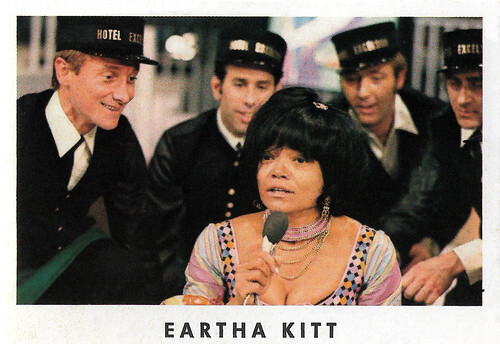
Vintage collectors card.
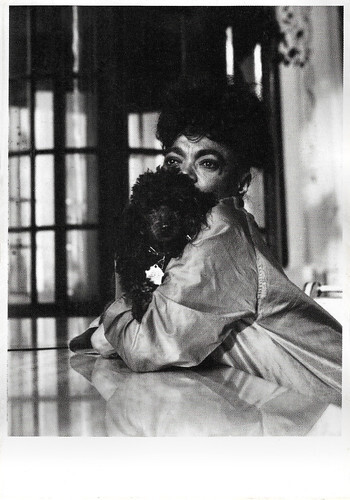
Dutch postcard by Art Unlimited, Amsterdam, no. B 84. Photo: Xavier Lambours. Caption: Eartha Kitt, 1982.
Sources: Wikipedia (Dutch, German and English) and .

American postcard by Fotofolio, New York, no. PH50. Photo: Philippe Halsman. Caption: Eartha Kitt, 1954.

American postcard by the American Postcard Co. Inc., no. 326, 1981. Photo: Arthur Rothstein. Caption: Eartha Kitt, 1953.
The first Afro-American modern ballet company
Eartha Mae Kitt was born on a cotton plantation in North in the southern state of South Carolina in 1927. Her father was of European and her mother was of African-American and Cherokee descent. Her father soon disappeared. At the age of eight, she was sent to New York to live with her aunt.
A big opportunity came when, at the age of 16, she was accepted into the Katherine Dunham Company, the first Afro-American modern ballet company. She made her film debut as a dancer in Casbah (John Berry, 1948), starring Yvonne De Carlo .
Orson Welles gave her a leading role as Helen of Troy in his production of Christopher Marlowe's play 'The Tragical History of Doctor Faustus' (1950). Welles called her "the most exciting woman in the world". Kitt had her final breakthrough in the Broadway show 'New Faces of 1952', in which she sang the song 'Monotonous'.
As a singer, Kitt had a number of hits in the 1950s and 1960s, including 'Let's Do It', 'C'est Si Bon', 'Just an Old Fashioned Girl', 'Monotonous', 'Love for Sale', 'I'd Rather Be Burned as a Witch', and 'Under the Bridges of Paris'. Her debut LP 'RCA Victor Presents Eartha Kitt' (1953) was in the top five on the US album charts. The 1953 Christmas song 'Santa Baby', about a woman who promises Santa a date in exchange for expensive gifts, was later covered by Madonna , Kylie Minogue and Ariana Grande.
In 1954/1955 she starred on Broadway in 'Mrs. Patterson' and in 1957 in 'Shinbone Alley. In Hollywood, she made her debut as Sidney Poitier 's co-star in the film The Mark of the Hawk (Michael Audley, 1957), followed by St. Louis Blues (Allen Resiner, 1958) with Nat 'King' Cole and Anna Lucasta (Arnold Laven, 1958) with Sammy Davis Jr. She appeared in more than 30 films.

British postcard in the Picturegoer Series, London, no. D672.

German postcard by Ufa/Film-Foto. Photo: John Everton.
Boycott and rehabilitation
In the 1960s, Eartha Kitt starred on Broadway in 'The Owl and the Pussycat'. On television, she appeared in the role of Catwoman in the series Batman as Julie Newmar 's successor. She also played a drug-addicted singer in Tennis Rackets and Guns (1965) and a guest role in Mission Impossible (1967). In Europe, she appeared in the film Onkel Toms Hütte/Uncle Tom's Cabin (Géza von Radványi, 1965), based on the novel 'Uncle Tom's Cabin'.
In 1968, at a White House luncheon, Kitt made Lady Bird Johnson, wife of US President Lyndon B. Johnson, cry with critical comments on the war in Vietnam. She bluntly told her, "You send the best of this country off to be shot and maimed. They rebel in the street. They don't want to go to school because they're going to be snatched off from their mothers to be shot in Vietnam." However, the public reaction to Kitt's statements was even more extreme both for and against her statements. After this, she was unable to get work in the United States and left for Europe, where she learned to speak French fluently.
This boycott ended in 1978 with rehabilitation by Jimmy Carter and she made her American comeback in the Broadway musical 'Timbuktu!' In the 1980s, she also made a comeback as a singer with the disco hits 'Where Is My Man' (1983), 'I Love Men' (1984), 'This Is My Life' (1986) and 'Cha-Cha Heels' (1989), a collaboration with Bronski Beat. In the 1990s, Kitt toured North America as the Wicked Witch in a stage version of 'The Wizard of Oz'.
She appeared in the documentary All By Myself: The Eartha Kitt Story (1983), starred in the film Erik the Viking (Terry Jones, 1989) starring Tim Robbins and had a small part in the comedy Boomerang (Reginald Hudlin, 1992) with Eddie Murphy. In the last years of her life, Kitt performed regularly as a comedian and musical star. She starred in the off-Broadway musical 'Mimi Le Duck' (2006) and in the film And Then Came Love (Richard Schenkman, 2007) starring Vanessa Williams. She also had voice roles in the animated films The Emperor's New Groove (Mark Dindal, 2000) and Madagascar: Escape 2 Africa (Eric Darnell, Tom McGrath, 2008).
In 2008, Eartha Kitt died in New York at the age of 81 from colon cancer. From 1960 to 1964, Eartha Kitt was married to real estate agent Bill McDonald. The marriage produced a daughter named Kitt Shapiro.

Vintage collectors card.

Dutch postcard by Art Unlimited, Amsterdam, no. B 84. Photo: Xavier Lambours. Caption: Eartha Kitt, 1982.
Sources: Wikipedia (Dutch, German and English) and .
Published on August 26, 2023 22:00
August 25, 2023
Photo by Haenchen
Karl Ludwig Haenchen (1911-2003) was a German photographer, television producer and pop songwriter and composer. He started as a fashion photographer in the 1930s. Haenchen's photos of German actors and musicians were used for countless star postcards during the 1940s and 1950s.
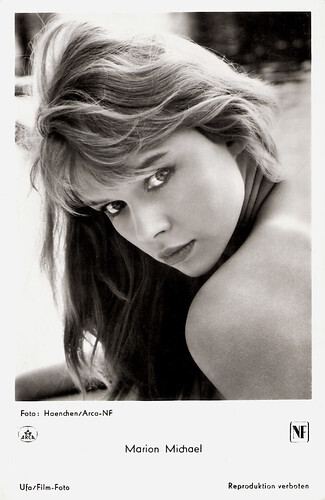
German postcard by Universum-Film Aktiengesellschaft (UFA), no. FK 3762. Retail price: 25 Pfg. Photo: Haenchen / Arca-NF. Marion Michael .
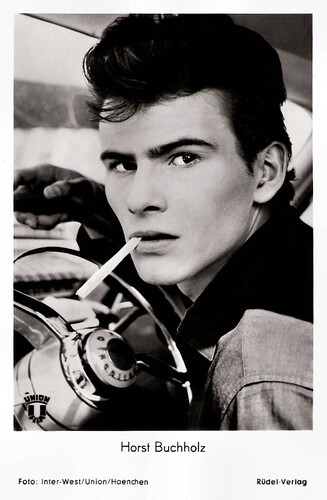
German postcard by Franz-Josef Rüdel, Hamburg-Bergedorf, no. 1858. Photo: Interwest / Union-Film / Haenchen. Horst Buchholz in Die Halbstarken/Teenage Wolfpack (Georg Tressler, 1956).
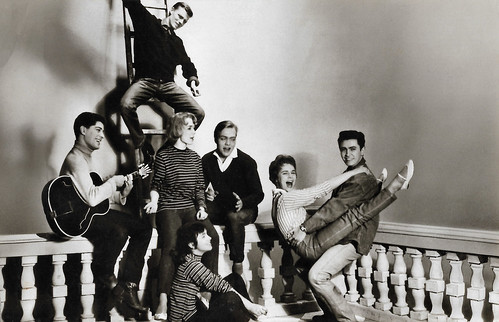
German postcard by Hans Josef Rüdel, Filmpostkartenverlag, Hamburg-Bergedorf, no. 2647. Photo: H.P. / Union / Haenchen. Conny Froboess , Rex Gildo , Richard Hellmann , Elke Arendt, Monika Leonhardt, Sergio Casmai and Hans Zander in Hula-Hopp, Conny (Heinz Paul, 1959).
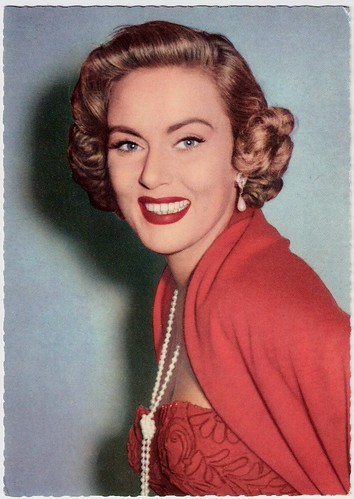
German postcard by ISV, no. M 13. Photo: Europa-Film / Haenchen. Nadia Gray .
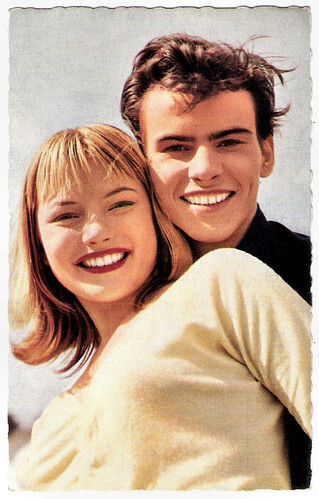
Austrian postcard by Lichtbild-Vertrieb Paula Weizmann, Wien, no. F 7. Photo: Interwest / Union-Film / Haenchen. Karin Baal and Horst Buchholz in Die Halbstarken/Teenage Wolfpack (Georg Tressler, 1956).
One of the most important fashion photographers of his time
Karl Ludwig Haenchen or K.L. Haenchen or simply Haenchen was born in 1911 in Berlin. He grew up as the eldest of seven children of the grammar school teacher and historian Karl Haenchen and his wife Erna Haenchen, née Fruchtermann in Kleinmachnow near Berlin. He was the nephew of the theologian Ernst Haenchen.
He initially studied history and sports for the teaching profession but then turned to photography, in which he was self-taught. Around 1930, he opened his first photo studio in Berlin, where he was considered one of the most important fashion photographers of his time in the 1930s and 1940s.
At times he ran three studios simultaneously in Berlin. From 1932 his photographs also appeared in fashion magazines such as 'Elegante Welt' (from 1935), 'Die Dame' (1936-1942), 'Die neue Linie (1936-1939), 'Hella' (1936-1942) and 'NS-Frauen-Warte (1936-1944). An early colour photograph appeared as the cover of 'Die Dame' in 1942.
In accordance with the style of the time, the models often appear in Haenchen's works shot from below. In this way, he also photographed hundreds of Nazi soldiers.
After the end of the war, Haenchen initially produced mainly portraits. Later, he returned to fashion and press photos for 'Film und Frau' (from 1948), 'Inspiration', 'Die Zeitschrift für die Dame' (from 1950) and the illustrated magazine 'Stern' (1950-1955).
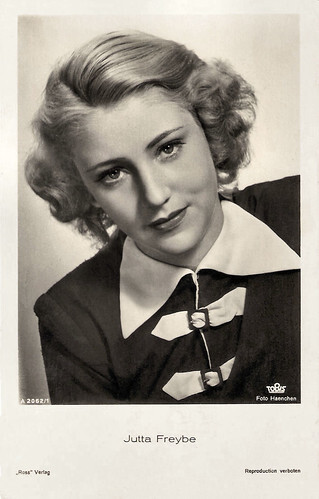
German postcard by Ross Verlag, no. A 2062/1, 1939-1940. Photo: Haenchen / Tobis. Jutta Freybe .
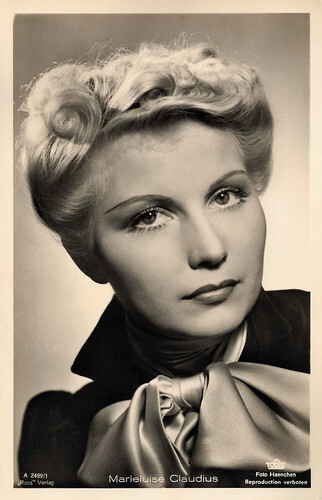
German postcard by Ross Verlag, no. A 2499/1, 1939-1940. Photo: Haenchen / Tobis. Marie Luise Claudius .
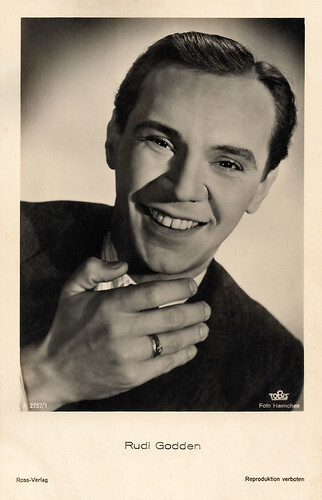
German postcard by Ross Verlag, no. A 2757/1, 1939-1940. Photo: Haenchen / Tobis. Rudi Godden .
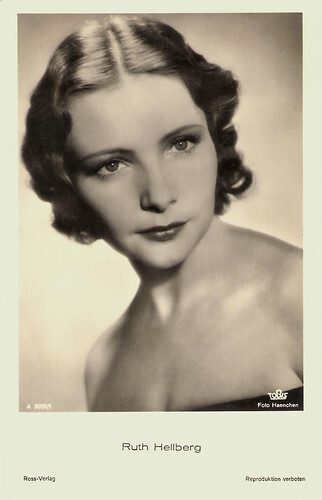
German Postcard by Ross Verlag, no. A 3059/1, 1941-1944. Photo: Haenchen / Tobis. Ruth Hellberg .
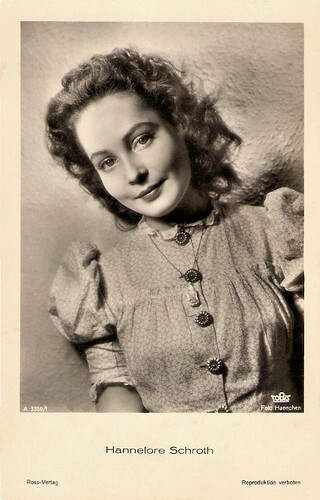
German Postcard by Ross Verlag, no. A 3359/1, 1941-1944. Photo: Haenchen / Tobis. Hannelore Schroth .
The Aryan Haenchen
In 1938, the Nazi Labour Inspectorate closed Atelier Binder, the studio of famous photographer Alex Binder , who had died in 1929. After his death, Mrs. Binder-Allemann and their two daughters were the owners of the photography studio. The manager was the Jewish Elisabeth Baroness von Stengel and the first operator was probably the photographer Hubs Floeter. They were employed at the studio until 1938 and Elisabeth Baroness von Stengel was deported to the Theresienstadt concentration camp in 1943.
The Aryan Haenchen moved in in 1938 and continued to make celebrity portraits. His film portraits were published on star postcards by such publishers as Film-Foto-Verlag. After World War II, the Hasse und Wiese company took over the studio in 1948 or 1949. Karl Ludwig Haenchen continued to work as a star photographer for the film company Sascha / Tobis.
In 1954 he moved to Hamburg. In the early 1960s, he wrote and composed a number of pop songs, including 'Don't Turn Around' (1961, with Bobby Schmidt), 'Paris is Worth a Trip' (1961, with Jupp Schmitz) and 'Das Glücksrad' (1962, with lyrics by Kurt Feltz) which was featured in the film Das süsse Leben des Grafen BobbyThe Sweet Life of Count Bobby (Géza von Cziffra, 1962) with Peter Alexander and Ingeborg Schöner.
He directed the short television film Eine weiße Hochzeitskutsche/A White Wedding Carriage (Karl Ludwig Haenchen, 1964) with Maria Litto and Klaus Beelitz, and also worked as a television producer in 1966. From 1970 he was no longer active as a photographer.
Karl Ludwig Haenchen passed away in 2003 in Dolcedo-Castellazzo in Italy. In his first marriage, Haenchen was married to the fashion journalist Petra Fiedler, née Behrens, the eldest daughter of the architect Peter Behrens. From 1948 he was married to Ilse Haenchen, née Oeberg (1918-2019), with whom he had two sons.
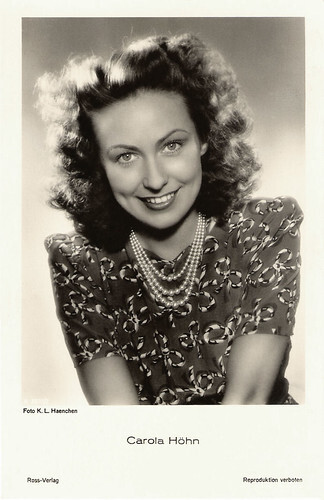
German postcard by Ross Verlag, no. A 3370/2, 1941-1944. Photo: K.L. Haenchen. Carola Höhn .
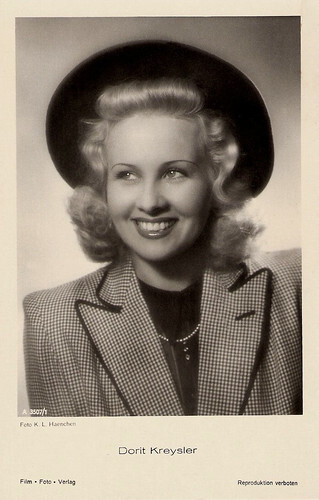
German postcard by Film-Foto-Verlag, no. A 3507/1, 1941-1944. Photo: K.L. Haenchen. Dorit Kreysler .
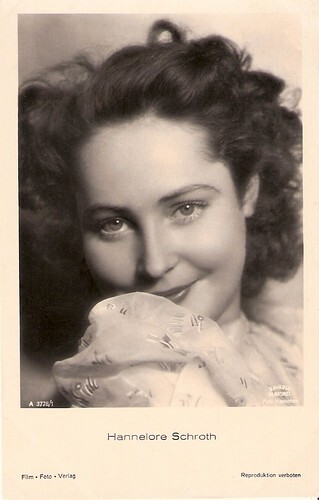
German postcard by Film-Foto-Verlag, no. A 3776/1, 1941-1944. Photo: Foto Haenchen / Bavaria Filmkunst. Hannelore Schroth .
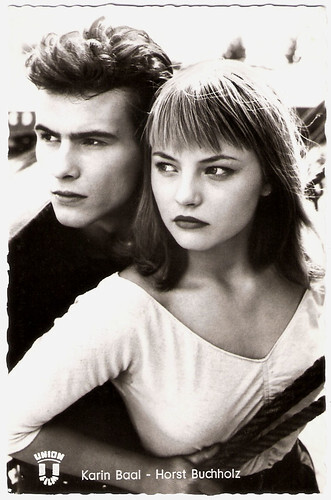
German postcard by Kolibri-Verlag, Minden/Westf., no. 2329. Photo: Interwest / Union / Haenchen. Horst Buchholz and Karin Baal in Die Halbstarken (Georg Tressler, 1956).
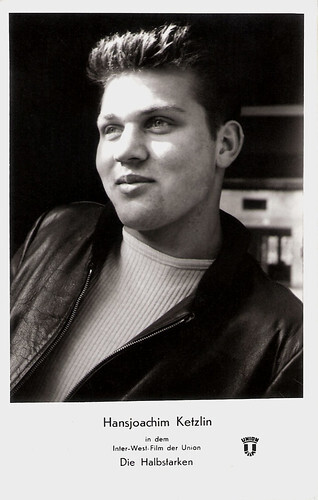
German postcard by Labaphot. Photo: Interwest / Union / Haenchen. Hansjoachim Ketzlin in Die Halbstarken (Georg Tressler, 1956).
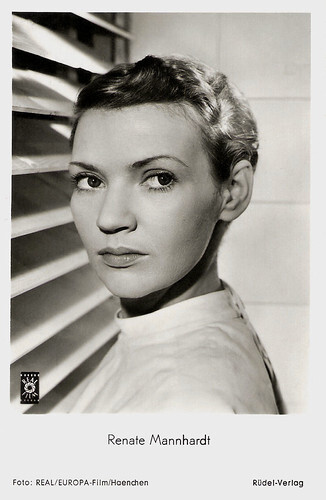
German postcard by Rüdel-Verlag, Hamburg-Bergedorf, no. 1635. Photo: Real / Europa-Film / Haenchen. Renate Mannhardt in Die Ehe des Dr. med. Danwitz/Marriage of Dr. Danwitz (Arthur Maria Rabenalt, 1956).
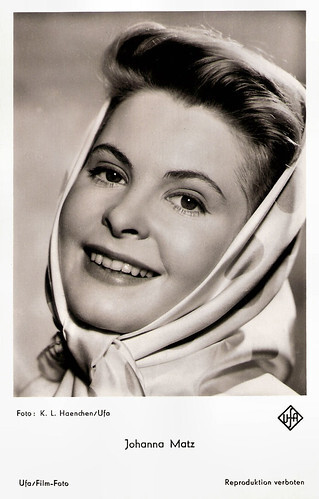
German postcard by Ufa, Berlin-Tempelhof, no. FK 4157. Photo: K.L. Haenchen / Ufa. Johanna Matz in Man müßte nochmal zwanzig sein/One would have to be twenty again (Hans Quest, 1958).
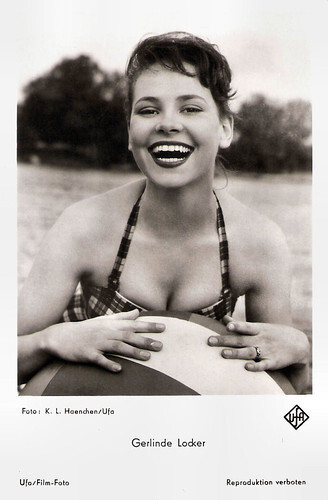
German postcard by Ufa, Berlin-Tempelhof, no. FK 4159. K.L. Haenchen / Ufa. Gerlinde Locker in Man müßte nochmal zwanzig sein/One would have to be twenty again (Hans Quest, 1958).
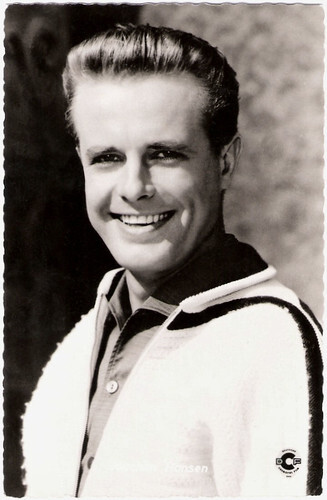
German postcard by Kolibri-Verlag G.m.b.H., Minden/Westf., no. 1071. Photo: Cinelux / Deutsche Cosmopol-film (DCF) / Haenchen. Joachim Hansen in Der Schatz vom Toplitzsee/The Treasure in Toplitz Lake (Franz Antel, 1959).
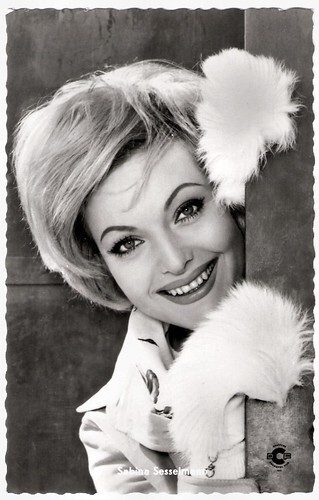
German postcard by Kolibri-Verlag G.m.b.H., Minden/Westf., no. 1112. Photo: Cinelux / Deutsche Cosmopol-Film (DCF) / Haenchen. Sabina Sesselmann in Der Schatz im Toplitzsee/The Treasure in Toplitz Lake (Franz Antel, 1959).
Sources: Wikipedia (German) and .

German postcard by Universum-Film Aktiengesellschaft (UFA), no. FK 3762. Retail price: 25 Pfg. Photo: Haenchen / Arca-NF. Marion Michael .

German postcard by Franz-Josef Rüdel, Hamburg-Bergedorf, no. 1858. Photo: Interwest / Union-Film / Haenchen. Horst Buchholz in Die Halbstarken/Teenage Wolfpack (Georg Tressler, 1956).

German postcard by Hans Josef Rüdel, Filmpostkartenverlag, Hamburg-Bergedorf, no. 2647. Photo: H.P. / Union / Haenchen. Conny Froboess , Rex Gildo , Richard Hellmann , Elke Arendt, Monika Leonhardt, Sergio Casmai and Hans Zander in Hula-Hopp, Conny (Heinz Paul, 1959).

German postcard by ISV, no. M 13. Photo: Europa-Film / Haenchen. Nadia Gray .

Austrian postcard by Lichtbild-Vertrieb Paula Weizmann, Wien, no. F 7. Photo: Interwest / Union-Film / Haenchen. Karin Baal and Horst Buchholz in Die Halbstarken/Teenage Wolfpack (Georg Tressler, 1956).
One of the most important fashion photographers of his time
Karl Ludwig Haenchen or K.L. Haenchen or simply Haenchen was born in 1911 in Berlin. He grew up as the eldest of seven children of the grammar school teacher and historian Karl Haenchen and his wife Erna Haenchen, née Fruchtermann in Kleinmachnow near Berlin. He was the nephew of the theologian Ernst Haenchen.
He initially studied history and sports for the teaching profession but then turned to photography, in which he was self-taught. Around 1930, he opened his first photo studio in Berlin, where he was considered one of the most important fashion photographers of his time in the 1930s and 1940s.
At times he ran three studios simultaneously in Berlin. From 1932 his photographs also appeared in fashion magazines such as 'Elegante Welt' (from 1935), 'Die Dame' (1936-1942), 'Die neue Linie (1936-1939), 'Hella' (1936-1942) and 'NS-Frauen-Warte (1936-1944). An early colour photograph appeared as the cover of 'Die Dame' in 1942.
In accordance with the style of the time, the models often appear in Haenchen's works shot from below. In this way, he also photographed hundreds of Nazi soldiers.
After the end of the war, Haenchen initially produced mainly portraits. Later, he returned to fashion and press photos for 'Film und Frau' (from 1948), 'Inspiration', 'Die Zeitschrift für die Dame' (from 1950) and the illustrated magazine 'Stern' (1950-1955).

German postcard by Ross Verlag, no. A 2062/1, 1939-1940. Photo: Haenchen / Tobis. Jutta Freybe .

German postcard by Ross Verlag, no. A 2499/1, 1939-1940. Photo: Haenchen / Tobis. Marie Luise Claudius .

German postcard by Ross Verlag, no. A 2757/1, 1939-1940. Photo: Haenchen / Tobis. Rudi Godden .

German Postcard by Ross Verlag, no. A 3059/1, 1941-1944. Photo: Haenchen / Tobis. Ruth Hellberg .

German Postcard by Ross Verlag, no. A 3359/1, 1941-1944. Photo: Haenchen / Tobis. Hannelore Schroth .
The Aryan Haenchen
In 1938, the Nazi Labour Inspectorate closed Atelier Binder, the studio of famous photographer Alex Binder , who had died in 1929. After his death, Mrs. Binder-Allemann and their two daughters were the owners of the photography studio. The manager was the Jewish Elisabeth Baroness von Stengel and the first operator was probably the photographer Hubs Floeter. They were employed at the studio until 1938 and Elisabeth Baroness von Stengel was deported to the Theresienstadt concentration camp in 1943.
The Aryan Haenchen moved in in 1938 and continued to make celebrity portraits. His film portraits were published on star postcards by such publishers as Film-Foto-Verlag. After World War II, the Hasse und Wiese company took over the studio in 1948 or 1949. Karl Ludwig Haenchen continued to work as a star photographer for the film company Sascha / Tobis.
In 1954 he moved to Hamburg. In the early 1960s, he wrote and composed a number of pop songs, including 'Don't Turn Around' (1961, with Bobby Schmidt), 'Paris is Worth a Trip' (1961, with Jupp Schmitz) and 'Das Glücksrad' (1962, with lyrics by Kurt Feltz) which was featured in the film Das süsse Leben des Grafen BobbyThe Sweet Life of Count Bobby (Géza von Cziffra, 1962) with Peter Alexander and Ingeborg Schöner.
He directed the short television film Eine weiße Hochzeitskutsche/A White Wedding Carriage (Karl Ludwig Haenchen, 1964) with Maria Litto and Klaus Beelitz, and also worked as a television producer in 1966. From 1970 he was no longer active as a photographer.
Karl Ludwig Haenchen passed away in 2003 in Dolcedo-Castellazzo in Italy. In his first marriage, Haenchen was married to the fashion journalist Petra Fiedler, née Behrens, the eldest daughter of the architect Peter Behrens. From 1948 he was married to Ilse Haenchen, née Oeberg (1918-2019), with whom he had two sons.

German postcard by Ross Verlag, no. A 3370/2, 1941-1944. Photo: K.L. Haenchen. Carola Höhn .

German postcard by Film-Foto-Verlag, no. A 3507/1, 1941-1944. Photo: K.L. Haenchen. Dorit Kreysler .

German postcard by Film-Foto-Verlag, no. A 3776/1, 1941-1944. Photo: Foto Haenchen / Bavaria Filmkunst. Hannelore Schroth .

German postcard by Kolibri-Verlag, Minden/Westf., no. 2329. Photo: Interwest / Union / Haenchen. Horst Buchholz and Karin Baal in Die Halbstarken (Georg Tressler, 1956).

German postcard by Labaphot. Photo: Interwest / Union / Haenchen. Hansjoachim Ketzlin in Die Halbstarken (Georg Tressler, 1956).

German postcard by Rüdel-Verlag, Hamburg-Bergedorf, no. 1635. Photo: Real / Europa-Film / Haenchen. Renate Mannhardt in Die Ehe des Dr. med. Danwitz/Marriage of Dr. Danwitz (Arthur Maria Rabenalt, 1956).

German postcard by Ufa, Berlin-Tempelhof, no. FK 4157. Photo: K.L. Haenchen / Ufa. Johanna Matz in Man müßte nochmal zwanzig sein/One would have to be twenty again (Hans Quest, 1958).

German postcard by Ufa, Berlin-Tempelhof, no. FK 4159. K.L. Haenchen / Ufa. Gerlinde Locker in Man müßte nochmal zwanzig sein/One would have to be twenty again (Hans Quest, 1958).

German postcard by Kolibri-Verlag G.m.b.H., Minden/Westf., no. 1071. Photo: Cinelux / Deutsche Cosmopol-film (DCF) / Haenchen. Joachim Hansen in Der Schatz vom Toplitzsee/The Treasure in Toplitz Lake (Franz Antel, 1959).

German postcard by Kolibri-Verlag G.m.b.H., Minden/Westf., no. 1112. Photo: Cinelux / Deutsche Cosmopol-Film (DCF) / Haenchen. Sabina Sesselmann in Der Schatz im Toplitzsee/The Treasure in Toplitz Lake (Franz Antel, 1959).
Sources: Wikipedia (German) and .
Published on August 25, 2023 22:00
August 24, 2023
Sally O'Neill
Cute and petite American actress Sally O'Neill (1908-1968) acted in almost 50 films between the mid-1920s and the mid-1930s. Her starring role in The Brat, directed by John Ford, was a highlight of her career. She also starred in several Broadway productions.
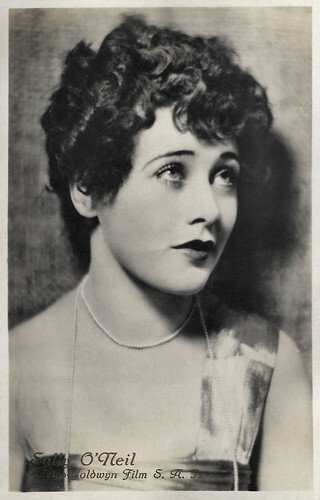
Italian postcard by G.B. Falci Editore, Milano, no. 530. Photo: Metro-Goldwyn Film S.A.I.
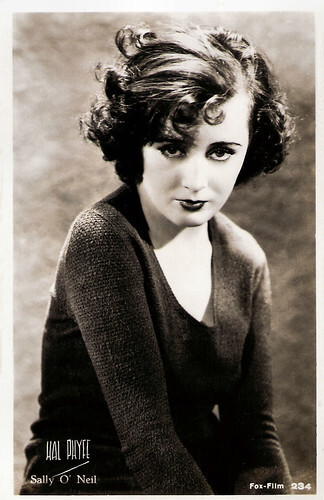
Dutch postcard by JosPe, no. 234. Photo: Hal Phyfe / Fox-Film.
Flashy fun girls
"Cute-as-a-button" and diminutive in size, Sally O'Neil (sometimes billed as Sally O'Neill), was born in 1908 in Bayonne, New Jersey. She was one of 11 children born to a Superior Court Judge, Thomas Francis Patrick Noonan, and his wife, Hannah Kelly, a one-time singer with the Metropolitan Opera.
Another sister would also become a well-known actress, Molly O'Day. Sally was educated in a convent and started in Vaudeville where she was billed as "Chotsie Noonan" (her real name was Virginia Louise Concepta Noonan).
She started in silent films at age 17 and found a penchant for playing unassuming street orphans along the lines of Mary Pickford in lightweight comedies, and later as flashy fun girls in the Clara Bow mould.
Sally found stardom with her second film Sally, Irene and Mary (Edmund Goulding, 1925) co-starring Constance Bennett and Joan Crawford playing a naive chorus girl.
As a result, she (as would sister Molly) was named a Wampas Baby Star in 1926.
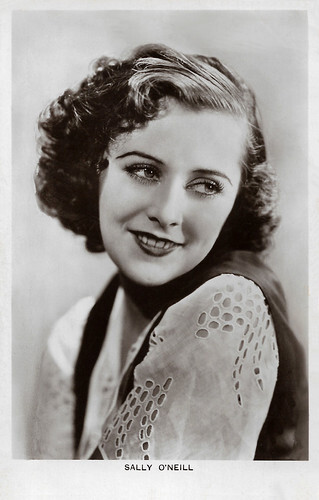
British postcard in the Picturegoer Series, London, no. 252a.
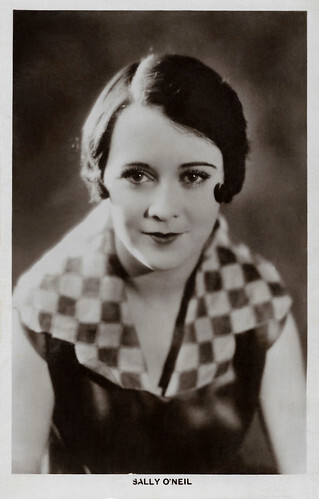
British postcard in the Picturegoer Series, London, no, 252.
A popular but brief MGM commodity
Memorable are Sally O'Neill's starring roles in Slide, Kelly, Slide (Edward Sedgwick, 1927) with William Haines , The Lovelorn (John P. McCarthy, 1927) also with Molly O'Day, and Broadway Scandals (George Archainbaud, 1929) with Jack Egan.
She also played leads in Jazz Heaven (Melville Brown, 1929) with Johnny Mack Brown, and Girl of the Port (Bert Glennon, 1930).She also played supporting parts in the Buster Keaton comedy Battling Butler (Buster Keaton, 1926) and D.W Griffith 's The Battle of the Sexes (1928). She would be a popular but brief MGM commodity.
Such films as The Callahans and the Murphys (George W. Hill, 1927) and Frisco Sally Levy (William Beaudine, 1927) did not suit her well and soon her star diminished. Possessing a strong New Jersey accent and developing a severe case of stage fright did not help things either as sound films were now the rage.
Despite the promising title role in Kathleen Mouverneen (Albert Ray, 1930) and a strong lead in the pre-Code film The Brat (John Ford, 1931), which she had done on Broadway, she quickly faded from view. Sally returned to the stage and performed in USO tours until retiring in the 1950s.
Divorced from her first husband, James Kenaston, in 1952, Sally married businessman Stewart S. Battles, former head of Midwest Manufacturing Co., a year later. They divorced in 1957, but would remarry. Sally O'Neill died of pneumonia in 1968 in Galesburg, Illinois. She was only 59.
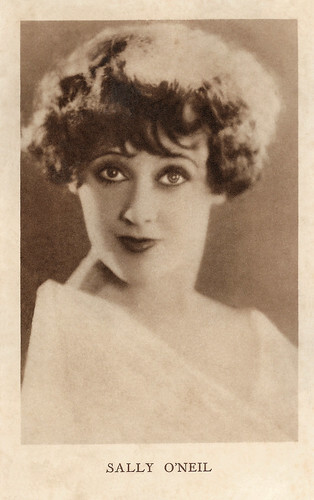
Belgian postcard by Weekblad 'Cinema', Antwerpen.
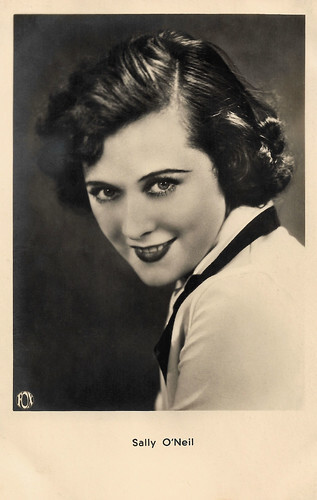
Austrian postcard by Iris Verlag, no. 6480. Photo: Fox.
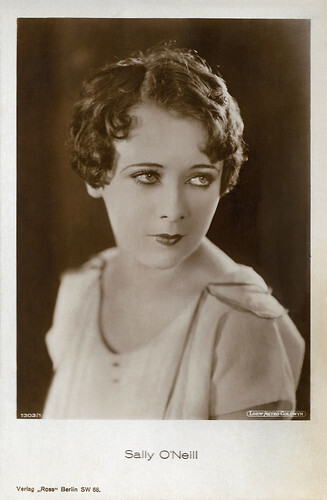
German postcard by Ross Verlag, no. 1303/1, 1927-1928. Photo: Loew-Metro-Goldwyn.
Sources: (IMDb), Find A Grave, Wikipedia and .

Italian postcard by G.B. Falci Editore, Milano, no. 530. Photo: Metro-Goldwyn Film S.A.I.

Dutch postcard by JosPe, no. 234. Photo: Hal Phyfe / Fox-Film.
Flashy fun girls
"Cute-as-a-button" and diminutive in size, Sally O'Neil (sometimes billed as Sally O'Neill), was born in 1908 in Bayonne, New Jersey. She was one of 11 children born to a Superior Court Judge, Thomas Francis Patrick Noonan, and his wife, Hannah Kelly, a one-time singer with the Metropolitan Opera.
Another sister would also become a well-known actress, Molly O'Day. Sally was educated in a convent and started in Vaudeville where she was billed as "Chotsie Noonan" (her real name was Virginia Louise Concepta Noonan).
She started in silent films at age 17 and found a penchant for playing unassuming street orphans along the lines of Mary Pickford in lightweight comedies, and later as flashy fun girls in the Clara Bow mould.
Sally found stardom with her second film Sally, Irene and Mary (Edmund Goulding, 1925) co-starring Constance Bennett and Joan Crawford playing a naive chorus girl.
As a result, she (as would sister Molly) was named a Wampas Baby Star in 1926.

British postcard in the Picturegoer Series, London, no. 252a.

British postcard in the Picturegoer Series, London, no, 252.
A popular but brief MGM commodity
Memorable are Sally O'Neill's starring roles in Slide, Kelly, Slide (Edward Sedgwick, 1927) with William Haines , The Lovelorn (John P. McCarthy, 1927) also with Molly O'Day, and Broadway Scandals (George Archainbaud, 1929) with Jack Egan.
She also played leads in Jazz Heaven (Melville Brown, 1929) with Johnny Mack Brown, and Girl of the Port (Bert Glennon, 1930).She also played supporting parts in the Buster Keaton comedy Battling Butler (Buster Keaton, 1926) and D.W Griffith 's The Battle of the Sexes (1928). She would be a popular but brief MGM commodity.
Such films as The Callahans and the Murphys (George W. Hill, 1927) and Frisco Sally Levy (William Beaudine, 1927) did not suit her well and soon her star diminished. Possessing a strong New Jersey accent and developing a severe case of stage fright did not help things either as sound films were now the rage.
Despite the promising title role in Kathleen Mouverneen (Albert Ray, 1930) and a strong lead in the pre-Code film The Brat (John Ford, 1931), which she had done on Broadway, she quickly faded from view. Sally returned to the stage and performed in USO tours until retiring in the 1950s.
Divorced from her first husband, James Kenaston, in 1952, Sally married businessman Stewart S. Battles, former head of Midwest Manufacturing Co., a year later. They divorced in 1957, but would remarry. Sally O'Neill died of pneumonia in 1968 in Galesburg, Illinois. She was only 59.

Belgian postcard by Weekblad 'Cinema', Antwerpen.

Austrian postcard by Iris Verlag, no. 6480. Photo: Fox.

German postcard by Ross Verlag, no. 1303/1, 1927-1928. Photo: Loew-Metro-Goldwyn.
Sources: (IMDb), Find A Grave, Wikipedia and .
Published on August 24, 2023 22:00
August 23, 2023
Robert Ryan
Distinguished American actor Robert Ryan (1909-1973) was known for his portrayals of hardened cops and ruthless villains. In 1948, he was nominated for an Oscar for his supporting role in Crossfire (1947). He achieved more fame with roles in Bad Day at Black Rock (1955), The Dirty Dozen (1967) and The Wild Bunch (1969).
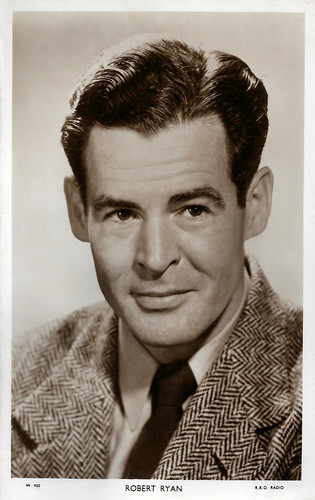
British postcard in the Picturegoer Series, London, no. W 950. Photo: R.K.O. Radio.
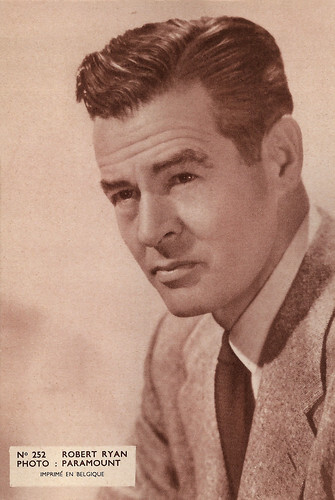
Belgian card, no. 252. Photo: Paramount.
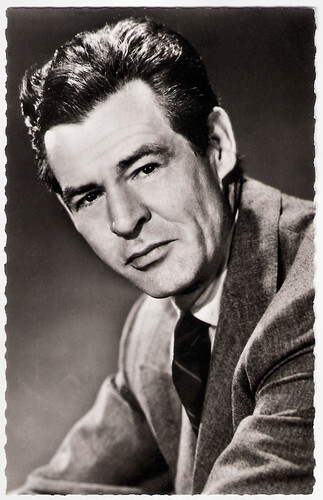
French postcard by Editions P.I., Paris, offered by Les Carbones Korès "Carboplane", no. 873. Photo: Paramount Pictures Inc.
Anti-semitic bully and murderer
Robert Bushnell Ryan was born in Chicago, Illinois, in 1909. He was the first child of Mabel Arbutus (née Bushnell), a secretary, and Timothy Aloysius Ryan, who was from a wealthy family who owned a real estate firm. Ryan's first successes came at Dartmouth College, where he held the school's heavyweight boxing title for all four years of his attendance, along with lettering in football and track.
After graduating in 1932, he worked in various odd jobs: as a stoker on a ship that travelled to Africa and as a roustabout on a ranch in Montana. He returned home in 1936 when his father died, and after a brief stint modelling clothes for a department store, he decided to become an actor. In 1937 Ryan joined a little theatre group in Chicago. The following year he enrolled in the Max Reinhardt Workshop in Hollywood.
His role in the 1939 play 'Too Many Husbands' brought an offer from Paramount. Although he had done a screen test for them in 1938 and been turned down as "not the right type", the studio offered him a $ 75-a-week contract. He made his debut as a boxer in Golden Gloves (Edward Dmytryk, 1940). Throughout the 1940s, he appeared on stage or in supporting roles in films on several occasions. In 1943, he signed a contract with RKO and was fourth-billed in Behind the Rising Sun (Edward Dmytryk, 1943), which was a huge box-office success. RKO promoted him to star status in Tender Comrade (Edward Dmytryk, 1943), where he was Ginger Rogers ' leading man. It was another big hit.
In 1944, he joined the United States Marine Corps and was active as a drill instructor at Camp Pendleton, in Southern California. There, he befriended writer/director Richard Brooks. After his discharge from the Marine Corps, RKO immediately cast Ryan in the Randolph Scott Western, Trail Street (Ray Enright, 1947), which was very popular. However, his next film, The Woman on the Beach (Jean Renoir, 1947) with Joan Bennett , lost money.
Ryan's big film breakthrough came with his role in Edward Dmytryk's superb Film Noir Crossfire (1947), based on the novel by Richard Brooks. For his portrayal of the anti-Semitic bully and murderer Montgomery, Ryan was nominated for an Oscar in the category of Best Supporting Actor in 1948. Ryan went on to become one of Hollywood's most versatile actors, able to play both the sympathetic leading man and the film villain. Some of Ryan's portrayals also blurred the lines between good and evil, which is probably why he was often cast in Film Noirs. In his personal favourite, The Set-Up (Robert Wise, 1949) he played a washed-up boxer who has to pay dearly for his last success in the ring.
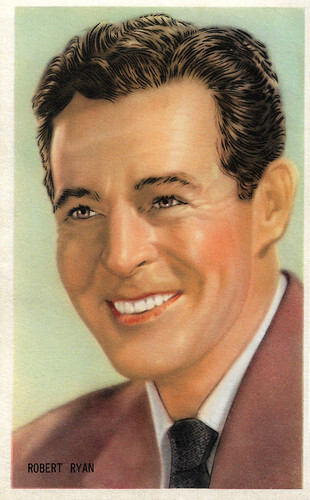
Belgian collectors card by Kwatta, Bois-d'Haine, no C. 211 (in the series C. 197 to C. 228). Photo: Film Enterprise / M.G.M. Robert Ryan in Caught (Max Ophüls, 1949).
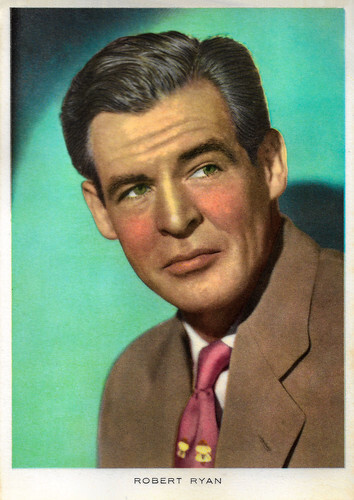
Italian postcard by Nannina, Milano.
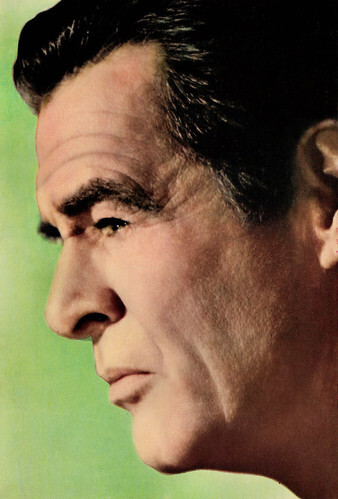
Spanish postcard by Postal Oscar Color S.A., Hospitalet (Barcelona), no. 668.
A hostile and jaded cop
For RKO, Robert Ryan starred in the Film Noir On Dangerous Ground (Nicholas Ray, 1951) in which he played a hostile and jaded cop opposite Gloria Grahame . Ryan went to MGM where he played a villain in Anthony Mann's Western The Naked Spur (1953), starring James Stewart . The picture was very popular.
Other successes were the suspense film Bad Day at Black Rock (John Sturges, 1955) in which he played the head villain opposite intrepid investigator Spencer Tracy and the grimy, gangster film Odds Against Tomorrow (Robert Wise, 1959) starring Harry Belafonte . In the summer of 1960, Ryan starred opposite Katharine Hepburn at the American Shakespeare Theatre in Stratford, Connecticut, playing Antony to Hepburn's Cleopatra.
Ryan remained in high demand throughout the 1960s and was part of some big productions that could count on an all-star cast. For instance, Ryan starred in the biblical epic King of Kings (Nicholas Ray, 1961), the all-star war film The Longest Day (Ken Annakin, Andrew Marton, Bernhard Wicki, Darryl F. Zanuck, 1962), the war adventure The Dirty Dozen (Robert Aldrich, 1967) and the violent Western The Wild Bunch (Sam Peckinpah, 1969).
On the political front, Ryan also made himself heard on several occasions. He was a liberal Democrat and a great defender of civil rights. In the McCarthy era, he joined the short-lived Committee for the First Amendment and protested against the persecution of the Hollywood Ten. Ryan's later political activities included efforts to fight racial discrimination. He served in the cultural division of the Committee to Defend Martin Luther King Jr., and helped organise the short-lived Artists Help All Blacks, with Bill Cosby, Robert Culp, and Sidney Poitier .
In 1972, Ryan's wife, former actress Jessica Cadwalader died of cancer. The two had been married to each other since 1939. Robert Ryan, a heavy smoker, died of lung cancer a year later at the age of 63. He left behind two sons and a daughter. His final film role was as the terminally-ill political activist Larry Slade in the drama The Iceman Cometh (John Frankenheimer, 1973), based on the play by Eugene O'Neill. For his performance, he was posthumously honoured with several awards including the National Board of Review Award.
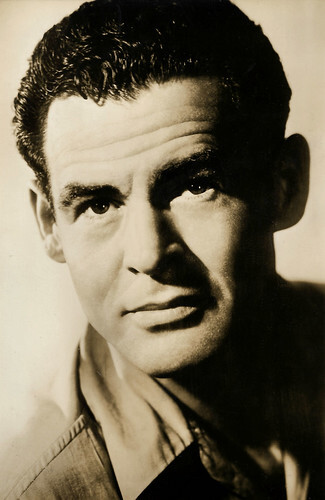
Spanish postcard by Kores Carboplan, no. 252. Photo: Mercurio Films.
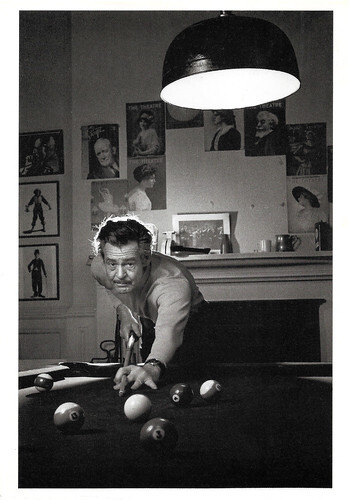
Swiss postcard by News Productions, Baulmes, no. 55047. Photo: Henri Dauman. Caption: Robert Ryan, The Dakota, New York City, 1969.
Sources: Wikipedia (Dutch, German and English) and.

British postcard in the Picturegoer Series, London, no. W 950. Photo: R.K.O. Radio.

Belgian card, no. 252. Photo: Paramount.

French postcard by Editions P.I., Paris, offered by Les Carbones Korès "Carboplane", no. 873. Photo: Paramount Pictures Inc.
Anti-semitic bully and murderer
Robert Bushnell Ryan was born in Chicago, Illinois, in 1909. He was the first child of Mabel Arbutus (née Bushnell), a secretary, and Timothy Aloysius Ryan, who was from a wealthy family who owned a real estate firm. Ryan's first successes came at Dartmouth College, where he held the school's heavyweight boxing title for all four years of his attendance, along with lettering in football and track.
After graduating in 1932, he worked in various odd jobs: as a stoker on a ship that travelled to Africa and as a roustabout on a ranch in Montana. He returned home in 1936 when his father died, and after a brief stint modelling clothes for a department store, he decided to become an actor. In 1937 Ryan joined a little theatre group in Chicago. The following year he enrolled in the Max Reinhardt Workshop in Hollywood.
His role in the 1939 play 'Too Many Husbands' brought an offer from Paramount. Although he had done a screen test for them in 1938 and been turned down as "not the right type", the studio offered him a $ 75-a-week contract. He made his debut as a boxer in Golden Gloves (Edward Dmytryk, 1940). Throughout the 1940s, he appeared on stage or in supporting roles in films on several occasions. In 1943, he signed a contract with RKO and was fourth-billed in Behind the Rising Sun (Edward Dmytryk, 1943), which was a huge box-office success. RKO promoted him to star status in Tender Comrade (Edward Dmytryk, 1943), where he was Ginger Rogers ' leading man. It was another big hit.
In 1944, he joined the United States Marine Corps and was active as a drill instructor at Camp Pendleton, in Southern California. There, he befriended writer/director Richard Brooks. After his discharge from the Marine Corps, RKO immediately cast Ryan in the Randolph Scott Western, Trail Street (Ray Enright, 1947), which was very popular. However, his next film, The Woman on the Beach (Jean Renoir, 1947) with Joan Bennett , lost money.
Ryan's big film breakthrough came with his role in Edward Dmytryk's superb Film Noir Crossfire (1947), based on the novel by Richard Brooks. For his portrayal of the anti-Semitic bully and murderer Montgomery, Ryan was nominated for an Oscar in the category of Best Supporting Actor in 1948. Ryan went on to become one of Hollywood's most versatile actors, able to play both the sympathetic leading man and the film villain. Some of Ryan's portrayals also blurred the lines between good and evil, which is probably why he was often cast in Film Noirs. In his personal favourite, The Set-Up (Robert Wise, 1949) he played a washed-up boxer who has to pay dearly for his last success in the ring.

Belgian collectors card by Kwatta, Bois-d'Haine, no C. 211 (in the series C. 197 to C. 228). Photo: Film Enterprise / M.G.M. Robert Ryan in Caught (Max Ophüls, 1949).

Italian postcard by Nannina, Milano.

Spanish postcard by Postal Oscar Color S.A., Hospitalet (Barcelona), no. 668.
A hostile and jaded cop
For RKO, Robert Ryan starred in the Film Noir On Dangerous Ground (Nicholas Ray, 1951) in which he played a hostile and jaded cop opposite Gloria Grahame . Ryan went to MGM where he played a villain in Anthony Mann's Western The Naked Spur (1953), starring James Stewart . The picture was very popular.
Other successes were the suspense film Bad Day at Black Rock (John Sturges, 1955) in which he played the head villain opposite intrepid investigator Spencer Tracy and the grimy, gangster film Odds Against Tomorrow (Robert Wise, 1959) starring Harry Belafonte . In the summer of 1960, Ryan starred opposite Katharine Hepburn at the American Shakespeare Theatre in Stratford, Connecticut, playing Antony to Hepburn's Cleopatra.
Ryan remained in high demand throughout the 1960s and was part of some big productions that could count on an all-star cast. For instance, Ryan starred in the biblical epic King of Kings (Nicholas Ray, 1961), the all-star war film The Longest Day (Ken Annakin, Andrew Marton, Bernhard Wicki, Darryl F. Zanuck, 1962), the war adventure The Dirty Dozen (Robert Aldrich, 1967) and the violent Western The Wild Bunch (Sam Peckinpah, 1969).
On the political front, Ryan also made himself heard on several occasions. He was a liberal Democrat and a great defender of civil rights. In the McCarthy era, he joined the short-lived Committee for the First Amendment and protested against the persecution of the Hollywood Ten. Ryan's later political activities included efforts to fight racial discrimination. He served in the cultural division of the Committee to Defend Martin Luther King Jr., and helped organise the short-lived Artists Help All Blacks, with Bill Cosby, Robert Culp, and Sidney Poitier .
In 1972, Ryan's wife, former actress Jessica Cadwalader died of cancer. The two had been married to each other since 1939. Robert Ryan, a heavy smoker, died of lung cancer a year later at the age of 63. He left behind two sons and a daughter. His final film role was as the terminally-ill political activist Larry Slade in the drama The Iceman Cometh (John Frankenheimer, 1973), based on the play by Eugene O'Neill. For his performance, he was posthumously honoured with several awards including the National Board of Review Award.

Spanish postcard by Kores Carboplan, no. 252. Photo: Mercurio Films.

Swiss postcard by News Productions, Baulmes, no. 55047. Photo: Henri Dauman. Caption: Robert Ryan, The Dakota, New York City, 1969.
Sources: Wikipedia (Dutch, German and English) and.
Published on August 23, 2023 22:00
August 22, 2023
The King and I (1956)
More than your eyes have ever seen... More than your heart has ever known! The King and I was one of the successes of Russian-born United States-based film and stage actor Yul Brynner (1920-1985), famous for his completely bald head. His portrayal of King Mongkut of Siam in the Rodgers and Hammerstein musical 'The King and I' was immediately a sensation. He played the role 4,625 times on stage and won two Tony Awards. For the film version, The King and I (Walter Lang, 1956) opposite Deborah Kerr as the widow who accepts a job as a live-in governess to the King of Siam's children, he also won the Academy Award.
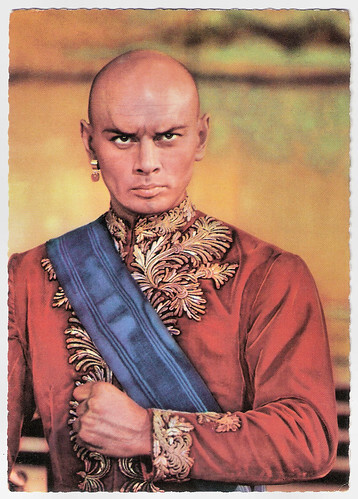
German postcard by ISV, no. A 50. Photo: 20th Century Fox. Yul Brynner in The King and I (Walter Lang, 1956).
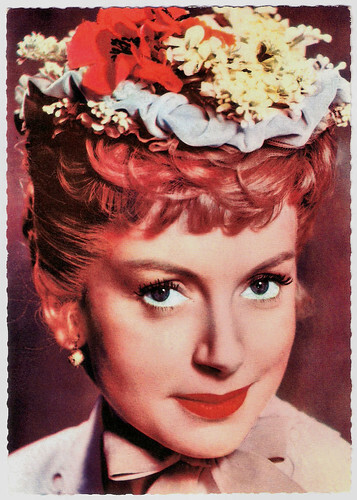
West-German postcard by ISV, no. A 55. Photo: 20th Century Fox. Deborah Kerr in The King and I (Walter Lang, 1956).
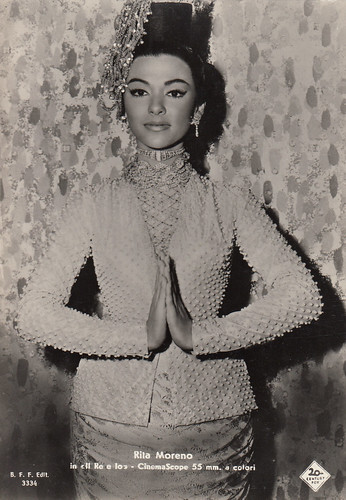
Italian postcard by Ballerini & Fratini, Firenze, no. 3334. Photo: 20th Century Fox. Rita Moreno , as the Burmese character Tuptim, in The King and I (Walter Lang, 1956). Collection: Marlene Pilaete.
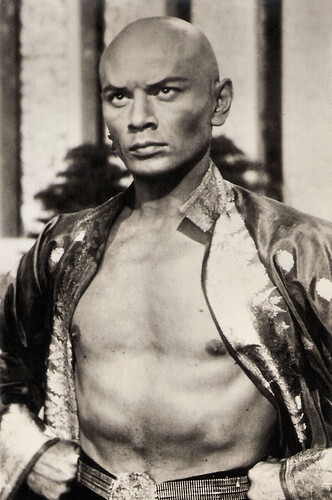
Spanish postcard by Archivo Bermejo, no. 239/5920, 1959. Photo: 20th Century Fox. Yul Brynner in The King and I (Walter Lang, 1956).
An immediate sensation
In 1946, The young Yul Brynner co-starred with Mary Martin in a Broadway production of 'Lute Song'. A few years later, he made his film debut in the Film Noir Port of New York (László Benedek, 1949) with Scott Brady.
The next year, at the urging of Mary Martin, he auditioned for Richard Rodgers and Oscar Hammerstein II's new musical, 'The King and I' (1951).
Yul Brynner became an immediate sensation. The part of King Mongkut would become his most famous role which he played 4625 times on stage. Brynner shaved his head for his role and continued to shave his head for the rest of his life.
Brynner's shaven head was unusual at the time, and his striking appearance helped to give him an exotic appeal. He won Tony Awards for both the first production in 1951 and for the Broadway revival in 1985.
In 1956, Yul Brynner also appeared in the film version, The King and I (Walter Lang, 1956), opposite Deborah Kerr as Mrs. Anna Leonowens. For his role, he won an Academy Award as Best Actor. Brynner is one of only nine people who have won both a Tony Award and an Academy Award for the same role.
Deborah Kerr won the Golden Globe Award for The King and I (1956). Her vocals in the film were dubbed by Marni Nixon. Kerr established a warm rapport with Nixon. According to Nixon, she and Kerr worked at least a week on each musical number and Nixon closely followed Kerr's movements during rehearsals on the set.
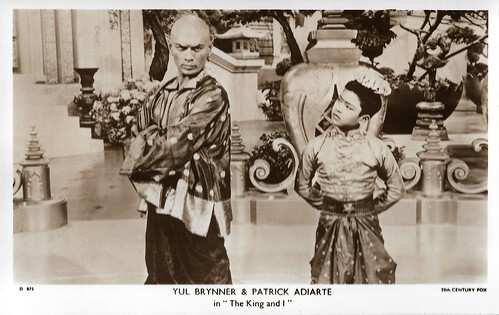
British postcard in the Picturegoer Series, London, no. D 875. Photo: 20th Century Fox. Yul Brynner and Patrick Adiarte in The King and I (Walter Lang, 1956).
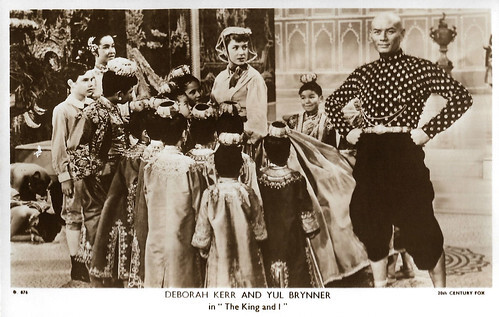
British postcard in the Picturegoer Series, London, no. D 876. Photo: 20th Century Fox. Yul Brynner and Deborah Kerr in The King and I (Walter Lang, 1956).
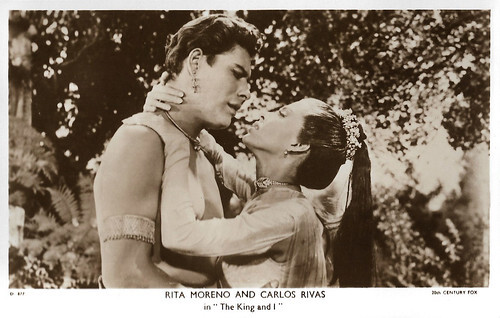
British postcard in the Picturegoer Series, London, no. D 877. Photo: 20th Century Fox. Rita Moreno and Carlos Rivas in The King and I (Walter Lang, 1956).
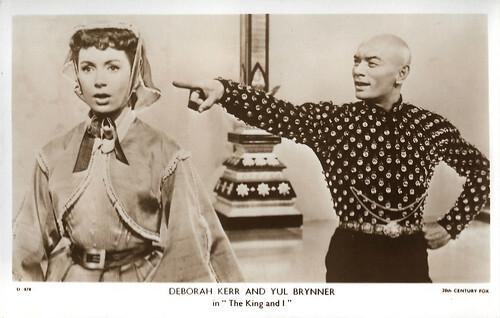
British postcard in the Picturegoer Series, London, no. D 878. Photo: 20th Century Fox. Deborah Kerr and Yul Brynner in The King and I (Walter Lang, 1956).
Governess to the children of King Mongkut of Siam
'The King and I' is the fifth musical by the team of Rodgers and Hammerstein. It is based on Margaret Landon's novel 'Anna and the King of Siam' (1944), which is in turn derived from the memoirs of Anna Leonowens, governess to the children of King Mongkut of Siam in the early 1860s. The musical's plot relates to the experiences of Anna, a British schoolteacher who is hired as part of the King's drive to modernise his country. The relationship between the King and Anna is marked by conflict through much of the piece, as well as by a love to which neither can admit.
In 1950, theatrical attorney Fanny Holtzmann sought a part for her client, veteran British actress Gertrude Lawrence. Holtzmann realised that Landon's book would provide an ideal vehicle. Holtzmann initially wanted Cole Porter to write the score, but he declined. She was going to approach Noël Coward next but happened to meet Dorothy Hammerstein (Oscar Hammerstein's wife) in Manhattan. Holtzmann told Dorothy that she wanted Rodgers and Hammerstein to create a show for Lawrence, and asked her to see her husband read a book that Holtzmann would send over.
In fact, both Dorothy Rodgers and Dorothy Hammerstein had read the novel in 1944 and had urged their husbands to consider it as a possible subject for a musical. Dorothy Hammerstein had known Gertrude Lawrence since 1925 when they had both appeared in André Charlot's London Revue of 1924 on Broadway and on tour in North America. Rodgers and Hammerstein were initially reluctant but agreed to write the musical. The pair initially sought Rex Harrison to play the supporting part of the King, a role he had played in the 1946 film made from Landon's book, Anna and the King of Siam (John Cromwell, 1946), but he was unavailable. They settled on the young actor and television director Yul Brynner .
The musical won Tony Awards for Best Musical, Best Actress (for Lawrence) and Best Featured Actor (for Brynner). Lawrence died unexpectedly of cancer a year and a half after the opening, and the role of Anna was played by several actresses during the remainder of the Broadway run of 1,246 performances. A hit West End London run and U.S. national tour followed, together with the film version, The King and I (Walter Lang, 1956), for which Yul Brynner won an Academy Award, and the musical was recorded several times. In later revivals, Brynner came to dominate his role and the musical, starring in a four-year national tour culminating in a 1985 Broadway run shortly before his death.
Yul Brynner also starred in a non-musical 1972 TV comedy series, with Samantha Eggar as "Anna Owens". CBS cancelled the series in mid-season after 13 episodes. It followed the main storyline of the musical, focusing on the relationship between the title characters. Christopher Renshaw directed major revivals on Broadway (1996), winning the Tony Award for Best Revival, and in the West End (2000). A 2015 Broadway revival won another Tony for Best Revival. Both professional and amateur revivals of 'The King and I' continue to be staged regularly throughout the English-speaking world.
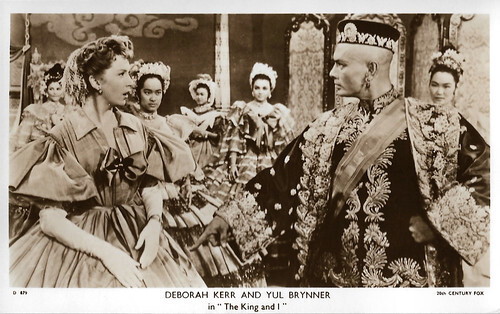
British postcard in the Picturegoer Series, London, no. D 879. Photo: 20th Century Fox. Yul Brynner and Deborah Kerr in The King and I (Walter Lang, 1956).
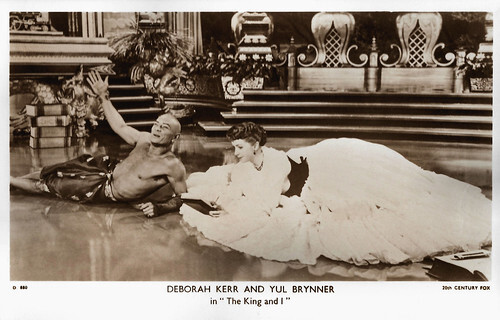
British postcard in the Picturegoer Series, London, no. D 880. Photo: 20th Century Fox. Deborah Kerr and Yul Brynner in The King and I (Walter Lang, 1956).
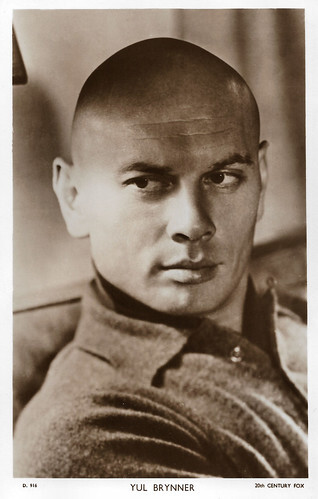
British postcard in the Picturegoer Series, London, no. D 916. Photo: 20th Century Fox. Yul Brynner in The King and I (Walter Lang, 1956).
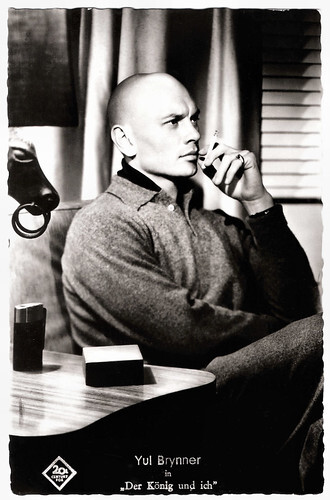
German postcard by Kolibri-Verlag, Minden-Westf., no. 2392. Photo: 20th Century Fox. Yul Brynner in The King and I (Walter Lang, 1956).
Sources: Wikipedia and IMDb.

German postcard by ISV, no. A 50. Photo: 20th Century Fox. Yul Brynner in The King and I (Walter Lang, 1956).

West-German postcard by ISV, no. A 55. Photo: 20th Century Fox. Deborah Kerr in The King and I (Walter Lang, 1956).

Italian postcard by Ballerini & Fratini, Firenze, no. 3334. Photo: 20th Century Fox. Rita Moreno , as the Burmese character Tuptim, in The King and I (Walter Lang, 1956). Collection: Marlene Pilaete.

Spanish postcard by Archivo Bermejo, no. 239/5920, 1959. Photo: 20th Century Fox. Yul Brynner in The King and I (Walter Lang, 1956).
An immediate sensation
In 1946, The young Yul Brynner co-starred with Mary Martin in a Broadway production of 'Lute Song'. A few years later, he made his film debut in the Film Noir Port of New York (László Benedek, 1949) with Scott Brady.
The next year, at the urging of Mary Martin, he auditioned for Richard Rodgers and Oscar Hammerstein II's new musical, 'The King and I' (1951).
Yul Brynner became an immediate sensation. The part of King Mongkut would become his most famous role which he played 4625 times on stage. Brynner shaved his head for his role and continued to shave his head for the rest of his life.
Brynner's shaven head was unusual at the time, and his striking appearance helped to give him an exotic appeal. He won Tony Awards for both the first production in 1951 and for the Broadway revival in 1985.
In 1956, Yul Brynner also appeared in the film version, The King and I (Walter Lang, 1956), opposite Deborah Kerr as Mrs. Anna Leonowens. For his role, he won an Academy Award as Best Actor. Brynner is one of only nine people who have won both a Tony Award and an Academy Award for the same role.
Deborah Kerr won the Golden Globe Award for The King and I (1956). Her vocals in the film were dubbed by Marni Nixon. Kerr established a warm rapport with Nixon. According to Nixon, she and Kerr worked at least a week on each musical number and Nixon closely followed Kerr's movements during rehearsals on the set.

British postcard in the Picturegoer Series, London, no. D 875. Photo: 20th Century Fox. Yul Brynner and Patrick Adiarte in The King and I (Walter Lang, 1956).

British postcard in the Picturegoer Series, London, no. D 876. Photo: 20th Century Fox. Yul Brynner and Deborah Kerr in The King and I (Walter Lang, 1956).

British postcard in the Picturegoer Series, London, no. D 877. Photo: 20th Century Fox. Rita Moreno and Carlos Rivas in The King and I (Walter Lang, 1956).

British postcard in the Picturegoer Series, London, no. D 878. Photo: 20th Century Fox. Deborah Kerr and Yul Brynner in The King and I (Walter Lang, 1956).
Governess to the children of King Mongkut of Siam
'The King and I' is the fifth musical by the team of Rodgers and Hammerstein. It is based on Margaret Landon's novel 'Anna and the King of Siam' (1944), which is in turn derived from the memoirs of Anna Leonowens, governess to the children of King Mongkut of Siam in the early 1860s. The musical's plot relates to the experiences of Anna, a British schoolteacher who is hired as part of the King's drive to modernise his country. The relationship between the King and Anna is marked by conflict through much of the piece, as well as by a love to which neither can admit.
In 1950, theatrical attorney Fanny Holtzmann sought a part for her client, veteran British actress Gertrude Lawrence. Holtzmann realised that Landon's book would provide an ideal vehicle. Holtzmann initially wanted Cole Porter to write the score, but he declined. She was going to approach Noël Coward next but happened to meet Dorothy Hammerstein (Oscar Hammerstein's wife) in Manhattan. Holtzmann told Dorothy that she wanted Rodgers and Hammerstein to create a show for Lawrence, and asked her to see her husband read a book that Holtzmann would send over.
In fact, both Dorothy Rodgers and Dorothy Hammerstein had read the novel in 1944 and had urged their husbands to consider it as a possible subject for a musical. Dorothy Hammerstein had known Gertrude Lawrence since 1925 when they had both appeared in André Charlot's London Revue of 1924 on Broadway and on tour in North America. Rodgers and Hammerstein were initially reluctant but agreed to write the musical. The pair initially sought Rex Harrison to play the supporting part of the King, a role he had played in the 1946 film made from Landon's book, Anna and the King of Siam (John Cromwell, 1946), but he was unavailable. They settled on the young actor and television director Yul Brynner .
The musical won Tony Awards for Best Musical, Best Actress (for Lawrence) and Best Featured Actor (for Brynner). Lawrence died unexpectedly of cancer a year and a half after the opening, and the role of Anna was played by several actresses during the remainder of the Broadway run of 1,246 performances. A hit West End London run and U.S. national tour followed, together with the film version, The King and I (Walter Lang, 1956), for which Yul Brynner won an Academy Award, and the musical was recorded several times. In later revivals, Brynner came to dominate his role and the musical, starring in a four-year national tour culminating in a 1985 Broadway run shortly before his death.
Yul Brynner also starred in a non-musical 1972 TV comedy series, with Samantha Eggar as "Anna Owens". CBS cancelled the series in mid-season after 13 episodes. It followed the main storyline of the musical, focusing on the relationship between the title characters. Christopher Renshaw directed major revivals on Broadway (1996), winning the Tony Award for Best Revival, and in the West End (2000). A 2015 Broadway revival won another Tony for Best Revival. Both professional and amateur revivals of 'The King and I' continue to be staged regularly throughout the English-speaking world.

British postcard in the Picturegoer Series, London, no. D 879. Photo: 20th Century Fox. Yul Brynner and Deborah Kerr in The King and I (Walter Lang, 1956).

British postcard in the Picturegoer Series, London, no. D 880. Photo: 20th Century Fox. Deborah Kerr and Yul Brynner in The King and I (Walter Lang, 1956).

British postcard in the Picturegoer Series, London, no. D 916. Photo: 20th Century Fox. Yul Brynner in The King and I (Walter Lang, 1956).

German postcard by Kolibri-Verlag, Minden-Westf., no. 2392. Photo: 20th Century Fox. Yul Brynner in The King and I (Walter Lang, 1956).
Sources: Wikipedia and IMDb.
Published on August 22, 2023 22:00
August 21, 2023
Rosa Porten
Rosa Porten (1884-1972) was the elder and lesser-known sister of German silent film star Henny Porten. Both sisters started in 1906 as an actress for the pioneering Messter company and Rosa became one of the first women in Germany to write and direct films.
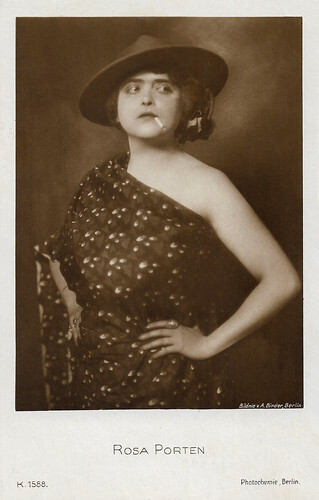
German postcard by Photochemie, Berlin, no. K. 1588. Photo: Alex Binder, Berlin.
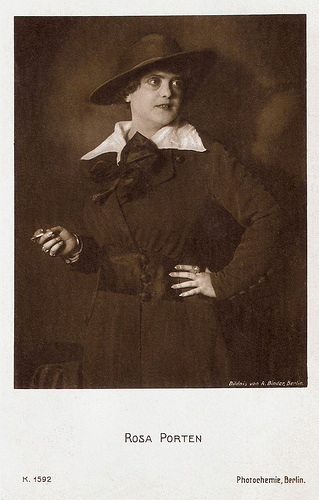
German postcard by Photochemie, Berlin, no. K. 1592. Photo: Alex Binder, Berlin.
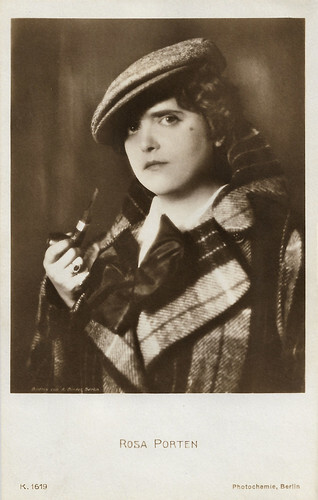
German postcard by Photochemie, Berlin, no. K. 1619. Photo: Alex Binder, Berlin.
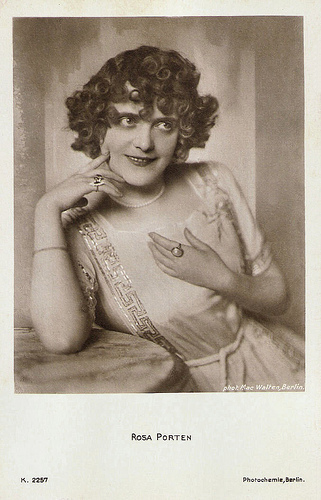
German postcard by Photochemie, Berlin, no. K. 2257. Photo: Mac Walten, Berlin.
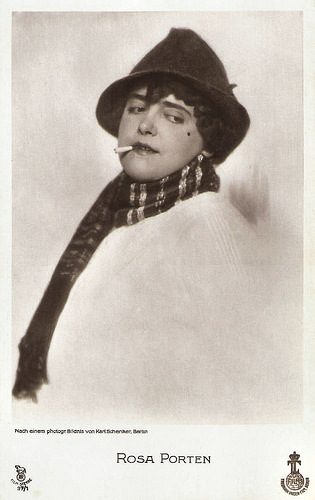
German postcard in the Film Sterne series by Rotophot, no. 97/1. Photo: Karl Schenker, Berlin / Treumann- Larsson Film, Berlin.
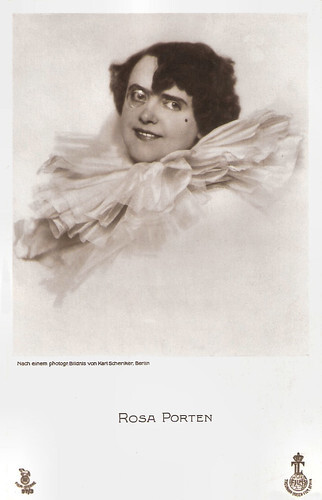
German postcard in the Film Sterne series by Rotophot, no. 97/3. Photo: Karl Schenker, Berlin / Treumann- Larsen Film, Berlin.
Writer-director
Rosa Porten was born in Düsseldorf, Germany, in 1884 (some sources say 1883 or 1889). She was the eldest daughter of opera baritone and later film director Franz Porten and his wife Vincenzia Porten-Wybiral. Her sister Henny Porten later became a legendary star of the German silent cinema.
As a child, Rosa got singing and acting lessons from her father and appeared together with her sister at school performances. Just like her sister, Rosa Porten's first film performance was in the 'Tonbild' (early sound film) Meissner Porzellan (1906) directed by their father for Messters Projektion GmbH. In the following years, she appeared in more of these early sound pictures like Die kleine Baronesse/The Little Daughter of the Baron (1908) and Im Fasching/In the Carnival (1908).
However, Rosa would be more active as a screenwriter than as an actress. She started this job with the Messter production Das Liebesglück der Blinden/The Joy of Love of the Blind (Heinrich Bolten-Baeckers, Curt A. Stark, 1911), in which her sister Henny made her debut as the leading lady opposite Friedrich Zelnik . In the 1910s, Rosa Porten was extremely active as a screenwriter for Messter and wrote such 20 minutes films as Das große Schweigen/The Great Silence (Rudolf Biebrach, 1915) starring her sister Henny.
For the Treumann-Larsen company, Rosa Porten and her husband Franz Eckstein wrote many scripts under the pseudonym of Dr. R. Portegg and they also directed these films. In some of these films, she even played the female lead too, such as in Die Wäscher-Resl (1916), the comedy Die Erzkokette (1917) with Reinhold Schünzel , the fast-paced comedy Die Landpommeranze/The Unwieldy Country Woman (1917), Die Augen der Schwester/The Eyes of the Sister (1918), and Themis (1918).
In other examples of these Treumann-Larsen productions like Das Opfer der Yella Rogesius/The Sacrifice of Yella Rogesius (1917) and Wanda's Trick (1918), Wanda Treumann played the lead. Probably the last film, which the couple Eckstein-Porten directed together, was Der nicht vom Weibe geborene (Franz Eckstein, Rosa Porten, 1918), starring Conrad Veidt as Satan. Rosa Porten also wrote such novels as 'Filmprinzeß' (Film Princess), 'Androgyne' and 'Die neue Generation' (The New Generation).
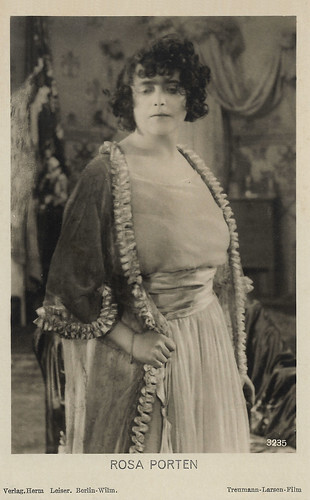
German postcard by Verlag Herm. Leiser, Berlin-Wilm., no. 3235. Photo: Treumann-Larsen-Film.
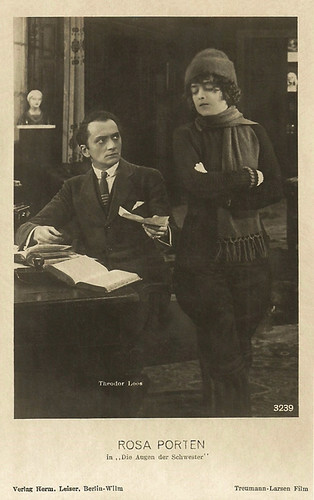
German postcard by Verlag Hermann Leiser, Berlin, no. 3239. Photo: Treumann-Larsen-Film. Rosa Porten and Theodor Loos in Die Augen der Schwester/The eyes of the sister (Franz Eckstein, 1918). Porten also scripted the film.
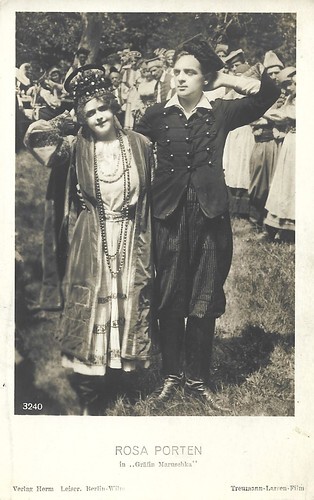
German postcard by Verlag Herm. Leiser, Berlin-Wilm., no 3240. Photo: Treumann-Larsen-Film. Rosa Porten and Max Wogritsch in Gräfin Maruschka/Countess Maruschka (Franz Eckstein, Rosa Porten, 1917).
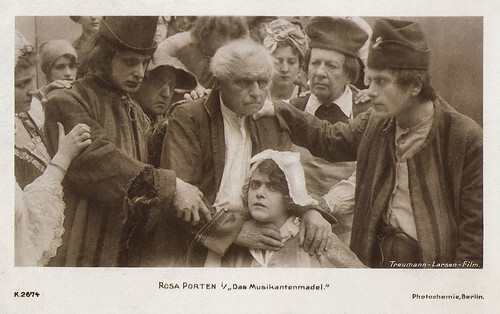
German postcard by Photochemie, Berlin, no. 2674. Photo: Treumann-Larssen-Film, Berlin. Rosa Porten in Das Musikantenmädel/The Musician Girl (N.N., 1918).
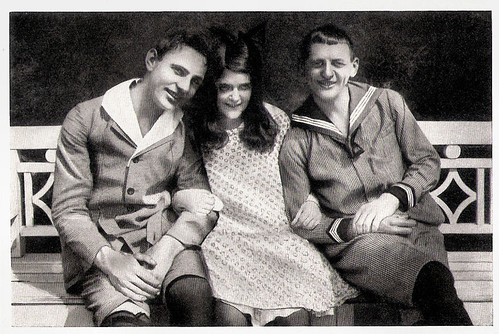
German collectors card by Ross Verlag for the album Vom Werden deutscher Filmkunst. Teil I. Der stumme Film (Cigaretten-Bilderdienst Altona-Bahrenfeld 1935), Bild no. 43, Gruppe 41. Photo: Treumann-Larsen-Film. Eduard von Winterstein, Rosa Porten and Reinhold Schünzel in Die Erzkokette/The Superflirt (Franz Eckstein, Rosa Porten, 1917).
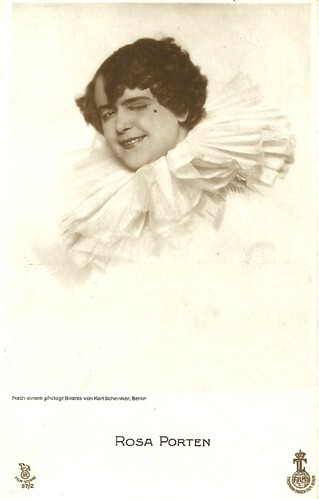
German postcard in the Film Sterne series by Rotophot, no. 57/2. Photo: Karl Schenker, Berlin / Treumann-Larsen-Film.
Scriptwriter
In the 1920s, Rosa Porten and Franz Eckstein went to work for the National-Film AG in Berlin, but with Porten only as a screenwriter and with Eckstein only as director. Examples of their films are Lotte Lore (1921) and Hedda Gabler (1924), starring Asta Nielsen .
In the mid-1920s, Eckstein and Porten stopped at National Film, but they did three more films: Das Mädchen aus der Fremde/The Foreign Girl (1926/27), Fahrendes Volk/Wandering Performers (1927), and Die Heiratsfalle/The marriage case (1928).
Afterwards, Rosa Porten stopped working as an actress. From 1931 to 1945 she lived happily in Pommern with Eckstein. Her husband died two months before the Russians and Poles invaded Pommern, forcing her to flee and ending up in Munich, where she wrote for newspapers, radio and cinema.
She had a small part in the Italo-German coproduction Land der Sehnsucht/Land of Longing (Erich Engel, Camillo Mastrocinque, 1950), which was never finished.
Rosa Porten died in Munich, Germany, in 1972.
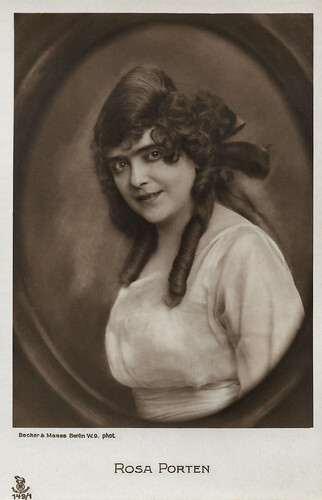
German postcard in the Film Sterne Series by Rotophot, no. 148/1. Photo: Becker & Maass, Berlin.
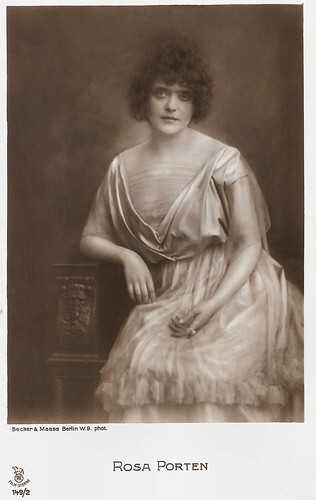
German postcard in the Film-Sterne series by Rotophot, no. 149/2. Photo: Becker & Maass.
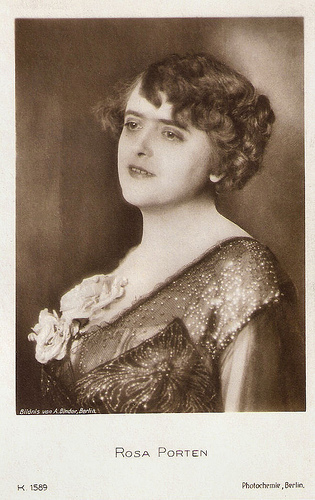
German postcard by Photochemie, Berlin, no. K. 1589. Photo: Alex Binder, Berlin.
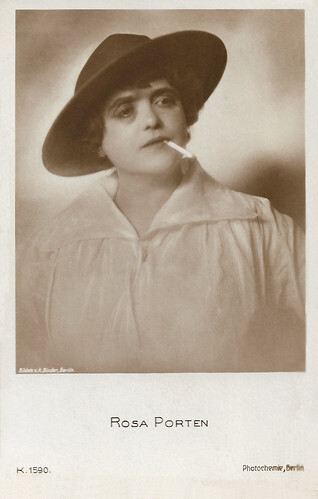
German postcard by Photochemie, Berlin, no. K. 1590. Photo: Alex Binder, Berlin.
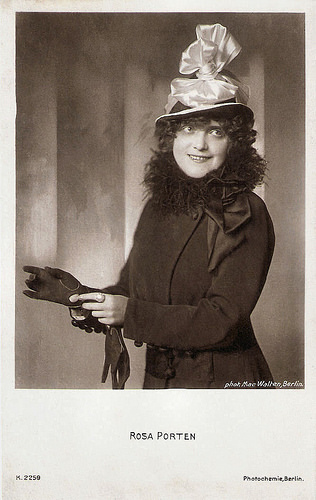
German postcard by Photochemie, Berlin, no. K. 2259. Photo: Mac Walten, Berlin.
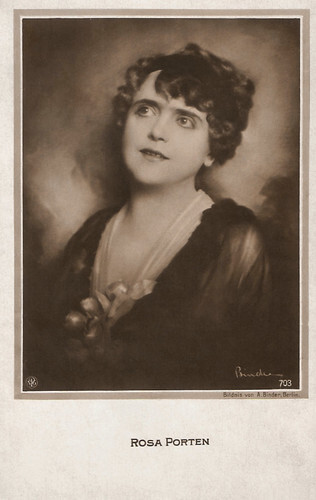
German postcard by NPG, no. 703. Photo: Alex Binder, Berlin.
Source: Gabriele Hansch, Gerlinde Waz (Filmportal.de - German), Thomas Staedeli (Cyranos), Wikipedia (German) and .

German postcard by Photochemie, Berlin, no. K. 1588. Photo: Alex Binder, Berlin.

German postcard by Photochemie, Berlin, no. K. 1592. Photo: Alex Binder, Berlin.

German postcard by Photochemie, Berlin, no. K. 1619. Photo: Alex Binder, Berlin.

German postcard by Photochemie, Berlin, no. K. 2257. Photo: Mac Walten, Berlin.

German postcard in the Film Sterne series by Rotophot, no. 97/1. Photo: Karl Schenker, Berlin / Treumann- Larsson Film, Berlin.

German postcard in the Film Sterne series by Rotophot, no. 97/3. Photo: Karl Schenker, Berlin / Treumann- Larsen Film, Berlin.
Writer-director
Rosa Porten was born in Düsseldorf, Germany, in 1884 (some sources say 1883 or 1889). She was the eldest daughter of opera baritone and later film director Franz Porten and his wife Vincenzia Porten-Wybiral. Her sister Henny Porten later became a legendary star of the German silent cinema.
As a child, Rosa got singing and acting lessons from her father and appeared together with her sister at school performances. Just like her sister, Rosa Porten's first film performance was in the 'Tonbild' (early sound film) Meissner Porzellan (1906) directed by their father for Messters Projektion GmbH. In the following years, she appeared in more of these early sound pictures like Die kleine Baronesse/The Little Daughter of the Baron (1908) and Im Fasching/In the Carnival (1908).
However, Rosa would be more active as a screenwriter than as an actress. She started this job with the Messter production Das Liebesglück der Blinden/The Joy of Love of the Blind (Heinrich Bolten-Baeckers, Curt A. Stark, 1911), in which her sister Henny made her debut as the leading lady opposite Friedrich Zelnik . In the 1910s, Rosa Porten was extremely active as a screenwriter for Messter and wrote such 20 minutes films as Das große Schweigen/The Great Silence (Rudolf Biebrach, 1915) starring her sister Henny.
For the Treumann-Larsen company, Rosa Porten and her husband Franz Eckstein wrote many scripts under the pseudonym of Dr. R. Portegg and they also directed these films. In some of these films, she even played the female lead too, such as in Die Wäscher-Resl (1916), the comedy Die Erzkokette (1917) with Reinhold Schünzel , the fast-paced comedy Die Landpommeranze/The Unwieldy Country Woman (1917), Die Augen der Schwester/The Eyes of the Sister (1918), and Themis (1918).
In other examples of these Treumann-Larsen productions like Das Opfer der Yella Rogesius/The Sacrifice of Yella Rogesius (1917) and Wanda's Trick (1918), Wanda Treumann played the lead. Probably the last film, which the couple Eckstein-Porten directed together, was Der nicht vom Weibe geborene (Franz Eckstein, Rosa Porten, 1918), starring Conrad Veidt as Satan. Rosa Porten also wrote such novels as 'Filmprinzeß' (Film Princess), 'Androgyne' and 'Die neue Generation' (The New Generation).

German postcard by Verlag Herm. Leiser, Berlin-Wilm., no. 3235. Photo: Treumann-Larsen-Film.

German postcard by Verlag Hermann Leiser, Berlin, no. 3239. Photo: Treumann-Larsen-Film. Rosa Porten and Theodor Loos in Die Augen der Schwester/The eyes of the sister (Franz Eckstein, 1918). Porten also scripted the film.

German postcard by Verlag Herm. Leiser, Berlin-Wilm., no 3240. Photo: Treumann-Larsen-Film. Rosa Porten and Max Wogritsch in Gräfin Maruschka/Countess Maruschka (Franz Eckstein, Rosa Porten, 1917).

German postcard by Photochemie, Berlin, no. 2674. Photo: Treumann-Larssen-Film, Berlin. Rosa Porten in Das Musikantenmädel/The Musician Girl (N.N., 1918).

German collectors card by Ross Verlag for the album Vom Werden deutscher Filmkunst. Teil I. Der stumme Film (Cigaretten-Bilderdienst Altona-Bahrenfeld 1935), Bild no. 43, Gruppe 41. Photo: Treumann-Larsen-Film. Eduard von Winterstein, Rosa Porten and Reinhold Schünzel in Die Erzkokette/The Superflirt (Franz Eckstein, Rosa Porten, 1917).

German postcard in the Film Sterne series by Rotophot, no. 57/2. Photo: Karl Schenker, Berlin / Treumann-Larsen-Film.
Scriptwriter
In the 1920s, Rosa Porten and Franz Eckstein went to work for the National-Film AG in Berlin, but with Porten only as a screenwriter and with Eckstein only as director. Examples of their films are Lotte Lore (1921) and Hedda Gabler (1924), starring Asta Nielsen .
In the mid-1920s, Eckstein and Porten stopped at National Film, but they did three more films: Das Mädchen aus der Fremde/The Foreign Girl (1926/27), Fahrendes Volk/Wandering Performers (1927), and Die Heiratsfalle/The marriage case (1928).
Afterwards, Rosa Porten stopped working as an actress. From 1931 to 1945 she lived happily in Pommern with Eckstein. Her husband died two months before the Russians and Poles invaded Pommern, forcing her to flee and ending up in Munich, where she wrote for newspapers, radio and cinema.
She had a small part in the Italo-German coproduction Land der Sehnsucht/Land of Longing (Erich Engel, Camillo Mastrocinque, 1950), which was never finished.
Rosa Porten died in Munich, Germany, in 1972.

German postcard in the Film Sterne Series by Rotophot, no. 148/1. Photo: Becker & Maass, Berlin.

German postcard in the Film-Sterne series by Rotophot, no. 149/2. Photo: Becker & Maass.

German postcard by Photochemie, Berlin, no. K. 1589. Photo: Alex Binder, Berlin.

German postcard by Photochemie, Berlin, no. K. 1590. Photo: Alex Binder, Berlin.

German postcard by Photochemie, Berlin, no. K. 2259. Photo: Mac Walten, Berlin.

German postcard by NPG, no. 703. Photo: Alex Binder, Berlin.
Source: Gabriele Hansch, Gerlinde Waz (Filmportal.de - German), Thomas Staedeli (Cyranos), Wikipedia (German) and .
Published on August 21, 2023 22:00
August 20, 2023
Three films with Hesperia: Jou-Jou (1916), La donna abbandonata (1917) and La principessa di Bagdad (1918)
Hesperia (1885-1959), was one of the Italian divas of the silent screen. She often worked with director Baldassarre Negroni, who later became her husband. In this post, you'll find three films the husband and wife team made for Tiber-film in Rome, Jou-Jou (1916), La donna abbandonata (1917) and La principessa di Bagdad (1918). Ivo Blom collected the Spanish cromo cards from the three films.
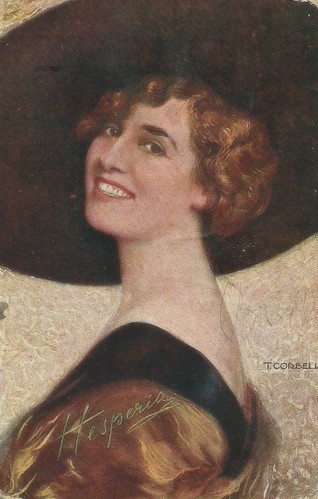
Italian postcard by Uff. Rev. Stampa, no. 229. Sent in Milano, 2-4-1917. Hesperia by Tito Corbella.
Jou-Jou (1916)
Jou-Jou ( Hesperia ) is adored by her husband but prefers Maurizio, married to her cousin, and passionate about horse racing.
They enjoy their moment of love in Amalfi, but once returned to France, Maurizio returns to his wife. Jou-Jou cannot take it anymore, and while taking a bath, she swallows poison.
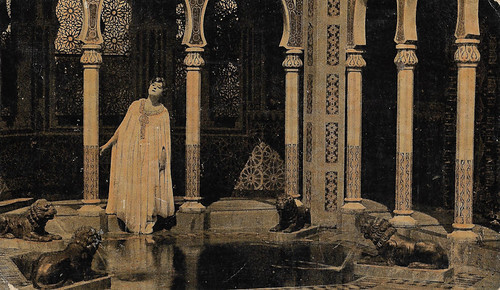
Spanish cromo card by Chocolate Imperiale, Barcelona, no. 6 of 6 cards. photo: Dist. J. Verdaguer / Tiber-film. Hesperia in Jou-Jou (Baldassarre Negroni, 1916). The set reminds us a bit of a cloister such as the Chiostro del Paradiso in Amalfi.
La donna abbandonata (1917)
Bonvivant Gaston de Neuil ( Tullio Carminati ) is tired of the Parisian excesses of the good life and looks for rest and fresh air at his family castle in the countryside. One night he sees a mysterious young woman passing the gate, with a sad expression. He finds out this is Claire de Beauscaut ( Hesperia ), a lady who for two years lives isolated at her castle of Courcelles.
Intrigued, he invents an excuse to see her, telling her he has grave news from Paris. He is immediately received, but when he asks to pardon for his fib Claire is surprised and scandalised at first. Afterwards, to relieve herself, she tells him her sad history...
The Italian press thought the basis of the film, a novella by Honoré de Balzac, too static and interiorised for the medium of film, but praised the mise-en-scene by Baldassarre Negroni, the cinematography by Renato Bini, and the actor's performances, in particular those of Hesperia and Tullio Carminati . The film had its Roman premiere on 16 July 1918.

Spanish cromo card by Chocolate Imperiale, Barcelona, no. 1 of 6 cards. photo: Dist. J. Verdaguer / Tiber-film. Hesperia and Tullio Carminati in La donna abbandonata/The abandoned woman (Baldassarre Negroni, 1917).
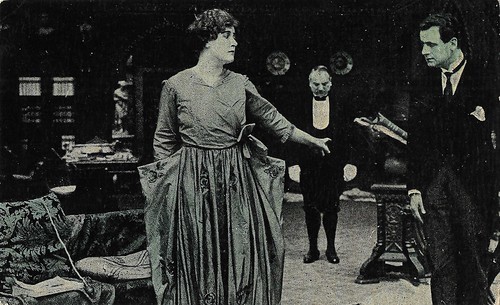
Spanish cromo card by Chocolate Imperiale, Barcelona, no. 2 of 6 cards. photo: Dist. J. Verdaguer / Tiber-film. Hesperia and Tullio Carminati in La donna abbandonata/The abandoned woman (Baldassarre Negroni, 1917).
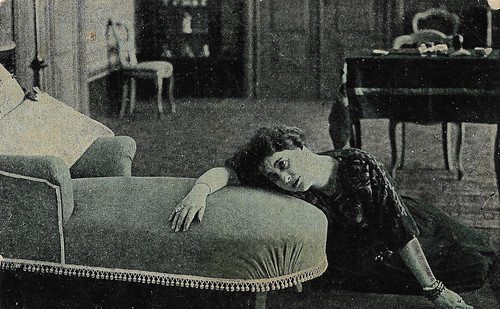
Spanish cromo card by Chocolate Imperiale, Barcelona, no. 4 of 6 cards. photo: Dist. J. Verdaguer / Tiber-film. Hesperia in La donna abbandonata/The abandoned woman (Baldassarre Negroni, 1917).
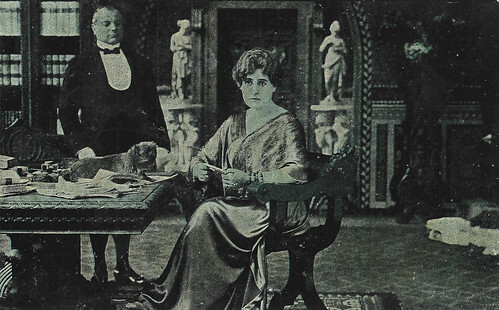
Spanish cromo card by Chocolate Imperiale, Barcelona, no. 5 of 6 cards. photo: Dist. J. Verdaguer / Tiber-film. Hesperia in La donna abbandonata/The abandoned woman (Baldassarre Negroni, 1917).
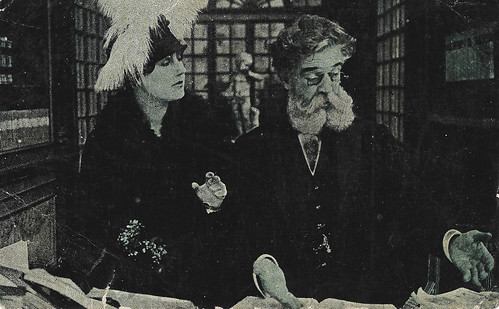
Spanish cromo card by Chocolate Imperiale, Barcelona, no. 6 of 6 cards. photo: Dist. J. Verdaguer / Tiber-film. Hesperia in La donna abbandonata/The abandoned woman (Baldassarre Negroni, 1917).
La principessa di Bagdad (1918)
Lionella ( Hesperia ) is the illegitimate daughter of the King of Bagdad and is recognised by her stepfather, the Count of Quansas. Raised a spoiled brat, when she marries Count Giovanni de Hun ( André Habay ), she squanders his richness lightly.
A family friend, Nourmandy (Goffredo d'Andrea), secretly in love with Lionella, pays all debts. De Hun believes his wife and Nourmandy are lovers, so he has them arrested by the police just when she is refusing another offer by Nourmandy.
Hurt in her pride by her husband's brutal behaviour, Lionella decides to leave with her lover, but her little son Raul begs her to refrain from such a step. Lionella's motherly love is bigger than her pride, so she chases the lover and pays off the debts with a generous donation by the dying, and repenting King. Her husband, at last, understands everything.
The plot was based on a play by Alexandre Dumas Fils. For cinematographer Renato Bini, it was his last film, as he prematurely died before the film came out.
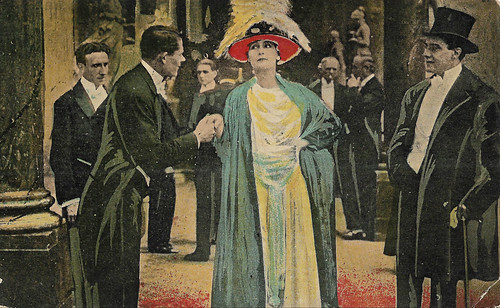
Spanish collectors card in the Colec. cromos cinematográficos by Chocolat Imperiale, no. 1 (in a series of 6 cromos). Photo: Tiber-film, Roma / J. Verdaguer, Barcelona. Hesperia and André Habay in La principessa di Bagdad/The Princess of Bagdad (Baldassarre Negroni, 1918).
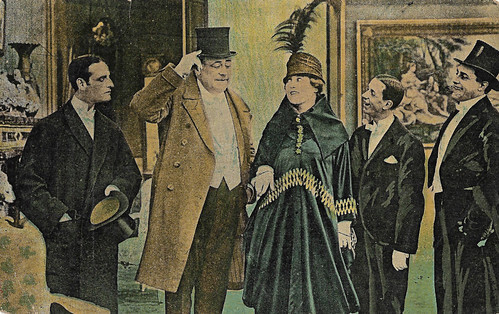
Spanish collectors card in the Colec. cromos cinematográficos by Chocolat Imperiale, no. 2 (in a series of 6 cromos). Photo: Tiber-film, Roma / J. Verdaguer, Barcelona. Hesperia and André Habay in La principessa di Bagdad/The Princess of Bagdad (Baldassarre Negroni, 1918). The man far left must be Goffredo d'Andrea.
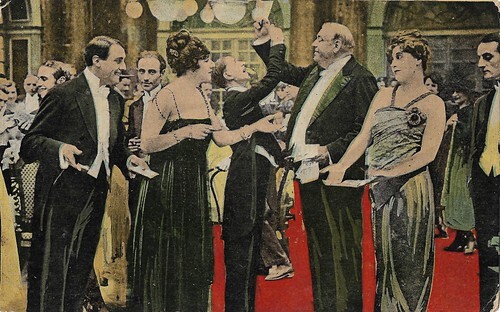
Spanish collectors card in the Colec. cromos cinematográficos by Chocolat Imperiale, no. 3 (in a series of 6 cromos). Photo: Tiber-film, Roma / J. Verdaguer, Barcelona. Hesperia and André Habay in La principessa di Bagdad/The Princess of Bagdad (Baldassarre Negroni, 1918). The man far right must be Goffredo d'Andrea.
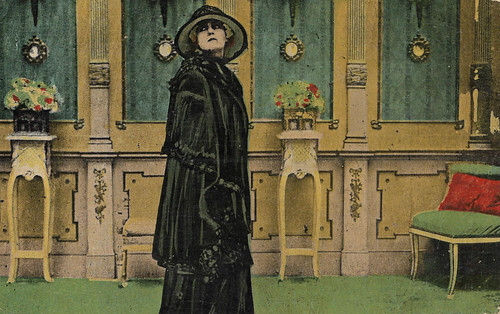
Spanish collectors card in the Colec. cromos cinematográficos by Chocolat Imperiale, no. 4 (in a series of 6 cromos). Photo: Tiber-film, Roma / J. Verdaguer, Barcelona. Hesperia in La principessa di Bagdad/The Princess of Bagdad (Baldassarre Negroni, 1918).
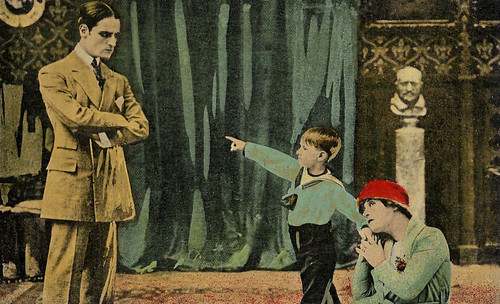
Spanish collectors card in the Colec. cromos cinematográficos by Chocolat Imperiale, no. 5 (in a series of 6 cromos). Photo: Tiber-film, Roma / J. Verdaguer, Barcelona. Hesperia in La principessa di Bagdad/The Princess of Bagdad (Baldassarre Negroni, 1918).
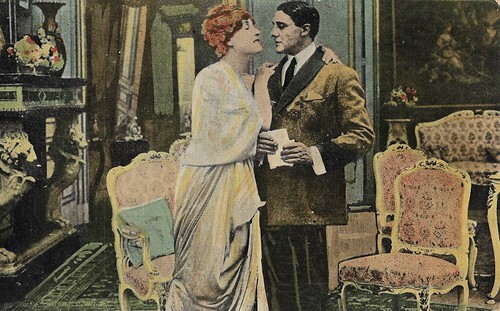
Spanish collectors card in the Colec. cromos cinematográficos by Chocolat Imperiale, no. 6 (in a series of 6 cromos). Photo: Tiber-film, Roma / J. Verdaguer, Barcelona. Hesperia and André Habay in La principessa di Bagdad/The Princess of Bagdad (Baldassarre Negroni, 1918).
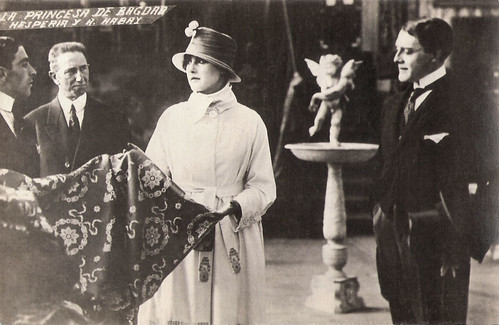
Spanish postcard. Hesperia and André Habay in La principessa di Bagdad/The Princess of Bagdad (Baldassarre Negroni, 1918).
Sources: Vittorio Martinelli (Il cinema muto italiano, Vol. 1917 - Italian), Wikipedia (Italian) and IMDb.

Italian postcard by Uff. Rev. Stampa, no. 229. Sent in Milano, 2-4-1917. Hesperia by Tito Corbella.
Jou-Jou (1916)
Jou-Jou ( Hesperia ) is adored by her husband but prefers Maurizio, married to her cousin, and passionate about horse racing.
They enjoy their moment of love in Amalfi, but once returned to France, Maurizio returns to his wife. Jou-Jou cannot take it anymore, and while taking a bath, she swallows poison.

Spanish cromo card by Chocolate Imperiale, Barcelona, no. 6 of 6 cards. photo: Dist. J. Verdaguer / Tiber-film. Hesperia in Jou-Jou (Baldassarre Negroni, 1916). The set reminds us a bit of a cloister such as the Chiostro del Paradiso in Amalfi.
La donna abbandonata (1917)
Bonvivant Gaston de Neuil ( Tullio Carminati ) is tired of the Parisian excesses of the good life and looks for rest and fresh air at his family castle in the countryside. One night he sees a mysterious young woman passing the gate, with a sad expression. He finds out this is Claire de Beauscaut ( Hesperia ), a lady who for two years lives isolated at her castle of Courcelles.
Intrigued, he invents an excuse to see her, telling her he has grave news from Paris. He is immediately received, but when he asks to pardon for his fib Claire is surprised and scandalised at first. Afterwards, to relieve herself, she tells him her sad history...
The Italian press thought the basis of the film, a novella by Honoré de Balzac, too static and interiorised for the medium of film, but praised the mise-en-scene by Baldassarre Negroni, the cinematography by Renato Bini, and the actor's performances, in particular those of Hesperia and Tullio Carminati . The film had its Roman premiere on 16 July 1918.

Spanish cromo card by Chocolate Imperiale, Barcelona, no. 1 of 6 cards. photo: Dist. J. Verdaguer / Tiber-film. Hesperia and Tullio Carminati in La donna abbandonata/The abandoned woman (Baldassarre Negroni, 1917).

Spanish cromo card by Chocolate Imperiale, Barcelona, no. 2 of 6 cards. photo: Dist. J. Verdaguer / Tiber-film. Hesperia and Tullio Carminati in La donna abbandonata/The abandoned woman (Baldassarre Negroni, 1917).

Spanish cromo card by Chocolate Imperiale, Barcelona, no. 4 of 6 cards. photo: Dist. J. Verdaguer / Tiber-film. Hesperia in La donna abbandonata/The abandoned woman (Baldassarre Negroni, 1917).

Spanish cromo card by Chocolate Imperiale, Barcelona, no. 5 of 6 cards. photo: Dist. J. Verdaguer / Tiber-film. Hesperia in La donna abbandonata/The abandoned woman (Baldassarre Negroni, 1917).

Spanish cromo card by Chocolate Imperiale, Barcelona, no. 6 of 6 cards. photo: Dist. J. Verdaguer / Tiber-film. Hesperia in La donna abbandonata/The abandoned woman (Baldassarre Negroni, 1917).
La principessa di Bagdad (1918)
Lionella ( Hesperia ) is the illegitimate daughter of the King of Bagdad and is recognised by her stepfather, the Count of Quansas. Raised a spoiled brat, when she marries Count Giovanni de Hun ( André Habay ), she squanders his richness lightly.
A family friend, Nourmandy (Goffredo d'Andrea), secretly in love with Lionella, pays all debts. De Hun believes his wife and Nourmandy are lovers, so he has them arrested by the police just when she is refusing another offer by Nourmandy.
Hurt in her pride by her husband's brutal behaviour, Lionella decides to leave with her lover, but her little son Raul begs her to refrain from such a step. Lionella's motherly love is bigger than her pride, so she chases the lover and pays off the debts with a generous donation by the dying, and repenting King. Her husband, at last, understands everything.
The plot was based on a play by Alexandre Dumas Fils. For cinematographer Renato Bini, it was his last film, as he prematurely died before the film came out.

Spanish collectors card in the Colec. cromos cinematográficos by Chocolat Imperiale, no. 1 (in a series of 6 cromos). Photo: Tiber-film, Roma / J. Verdaguer, Barcelona. Hesperia and André Habay in La principessa di Bagdad/The Princess of Bagdad (Baldassarre Negroni, 1918).

Spanish collectors card in the Colec. cromos cinematográficos by Chocolat Imperiale, no. 2 (in a series of 6 cromos). Photo: Tiber-film, Roma / J. Verdaguer, Barcelona. Hesperia and André Habay in La principessa di Bagdad/The Princess of Bagdad (Baldassarre Negroni, 1918). The man far left must be Goffredo d'Andrea.

Spanish collectors card in the Colec. cromos cinematográficos by Chocolat Imperiale, no. 3 (in a series of 6 cromos). Photo: Tiber-film, Roma / J. Verdaguer, Barcelona. Hesperia and André Habay in La principessa di Bagdad/The Princess of Bagdad (Baldassarre Negroni, 1918). The man far right must be Goffredo d'Andrea.

Spanish collectors card in the Colec. cromos cinematográficos by Chocolat Imperiale, no. 4 (in a series of 6 cromos). Photo: Tiber-film, Roma / J. Verdaguer, Barcelona. Hesperia in La principessa di Bagdad/The Princess of Bagdad (Baldassarre Negroni, 1918).

Spanish collectors card in the Colec. cromos cinematográficos by Chocolat Imperiale, no. 5 (in a series of 6 cromos). Photo: Tiber-film, Roma / J. Verdaguer, Barcelona. Hesperia in La principessa di Bagdad/The Princess of Bagdad (Baldassarre Negroni, 1918).

Spanish collectors card in the Colec. cromos cinematográficos by Chocolat Imperiale, no. 6 (in a series of 6 cromos). Photo: Tiber-film, Roma / J. Verdaguer, Barcelona. Hesperia and André Habay in La principessa di Bagdad/The Princess of Bagdad (Baldassarre Negroni, 1918).

Spanish postcard. Hesperia and André Habay in La principessa di Bagdad/The Princess of Bagdad (Baldassarre Negroni, 1918).
Sources: Vittorio Martinelli (Il cinema muto italiano, Vol. 1917 - Italian), Wikipedia (Italian) and IMDb.
Published on August 20, 2023 22:00
Paul van Yperen's Blog
- Paul van Yperen's profile
- 13 followers
Paul van Yperen isn't a Goodreads Author
(yet),
but they
do have a blog,
so here are some recent posts imported from
their feed.



